
The Bottom Line
Introduction, Quick Specs and Availability & Price
One of the first three NVIDIA GeForce GTX 960 reviews we have coming in droves is from EVGA, who sent us its GeForce GTX 960 SuperSC ACX 2.0+ (or SuperSuperClocked) video card. As I'm based in Australia, EVGA has always been one of those premium brands that has attracted attention from across the pond. I worked in IT retail selling various PC parts, including EVGA video cards, as they were one of the more popular brands that consumers purchased.
EVGA has deployed its new ACX 2.0+ cooler, which we're going to go into detail about later on in the review. But the cooler (I'm sure) will not only perform well, but it looks slick. Two of these cards in SLI are going to look beautiful, that's for sure.

EVGA has four cards in its GeForce GTX 960 line up; the GTX 960 FTW ACX 2.0+, GTX 960 SuperSC ACX 2.0+ (which we have here today), the GTX 960 ACX 2.0+, and finally, the GTX 960 Superclocked. All four cards are built with EVGA's normal eye for extremely good quality, with varying overclocks and coolers.
Quick Specs
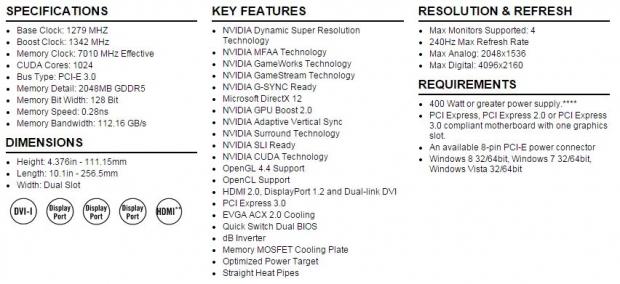
As with most GeForce GTX 960 cards, we're not seeing a huge change from the usual layout or specifications apart from the cooling, PCIe power connector and of course, the clock speeds. EVGA has a Base Clock of 1279MHz, with a Boost Clock of 1342MHz. This is compared to NVIDIA's reference spec of 1126MHz for the Base Clock and Boost Clock of 1178MHz. EVGA has performed a decent overclock here, something that should perform well against the competition.
We also have the same 2GB of VRAM on a 128-bit memory bus, with 112.1GB/sec of available memory bandwidth. Display output wise, we have the same three DisplayPort, one HDMI 2.0 and one dual-link DVI that most cards are shipping with from NVIDIA in the 900 series now.
Availability & Price
Better yet, EVGA has a price of just $209.99 for the GeForce GTX 960 SuperSC ACX 2.0+ video card, which is available right now through Amazon, with its Prime service available on it too. Considering the GTX 970 Superclocked ACX 2.0 from EVGA is priced at $342.39 on Amazon, it'll be interesting to see how the card performs against the GTX 970, which is close to half the price.
We'll reach out to EVGA to try and secure one of those, and have a battle between the EVGA GeForce GTX 900 series in the near future.
PRICING: You can find the EVGA GeForce GTX 960 SuperSC ACX 2.0+ 2GB GDDR5 for sale below. The prices listed are valid at the time of writing but can change at any time. Click the link to see the very latest pricing for the best deal.
United States: The EVGA GeForce GTX 960 SuperSC ACX 2.0+ 2GB GDDR5 retails for $209.99 at Amazon.
Packaging & Box Contents
Packaging
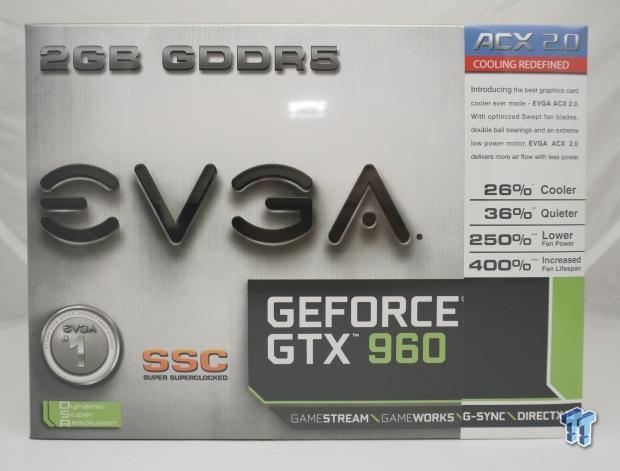
The front of the EVGA GeForce GTX 960 SuperSC ACX 2.0+ box is nice and plain, and to the right, we can see that this has the ACX 2.0+ cooler, which is explained as being much better than competing cards and coolers.
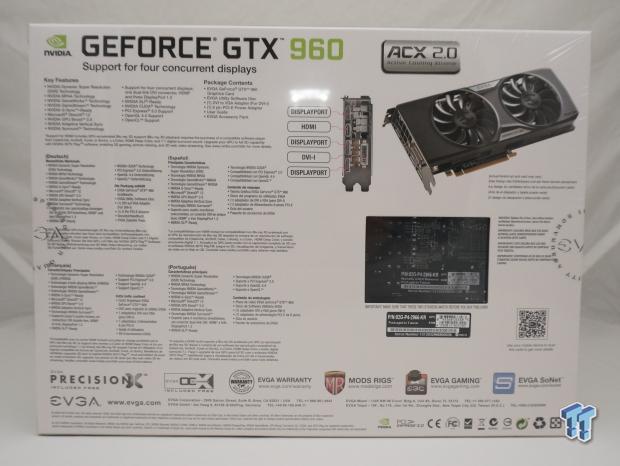
On the back, we have a fully detailed rundown of what to expect not just from the video card, but from the Maxwell architecture underneath. We also find out the display output configuration, and we have multiple languages to boot.

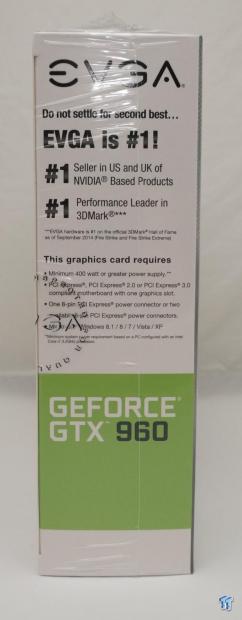
On the sides of the box, we get a rundown of the ACX 2.0+ cooler and that EVGA is still the #1 seller of US and UK cards for NVIDIA.


The bottom, and top of the box.
Box Contents
Inside of the box, was much more than I expected.
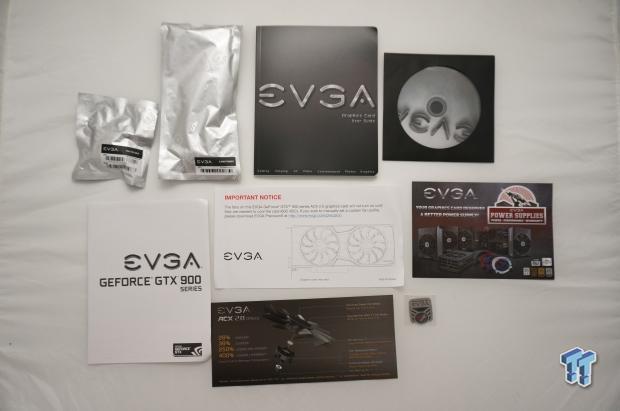
We have a lot of things in the box, starting from the top left, we have a DVI to VGA connector and 8-pin power connector. From there, we have the User Guide, installation CD, manual, important notice on the fans not spinning unless the card gets above 60-65C, a look at EVGA's range of power supplies, a deeper look at the ACX 2.0+ cooler, and a wicked sticker to slap on the front of your case.
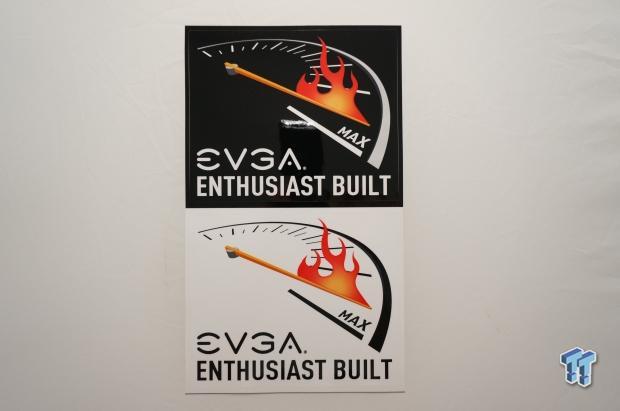
There's even a massive poster in the box, and an even bigger duo of stickers, too.
Detailed Look
EVGA has a truly beautiful card on its hands with the GTX 960 SuperSC ACX 2.0, something I fell in love with instantly. The company provides an excellent detailed rundown of the ACX 2.0+ cooling on its website, which you can see in the shot below.
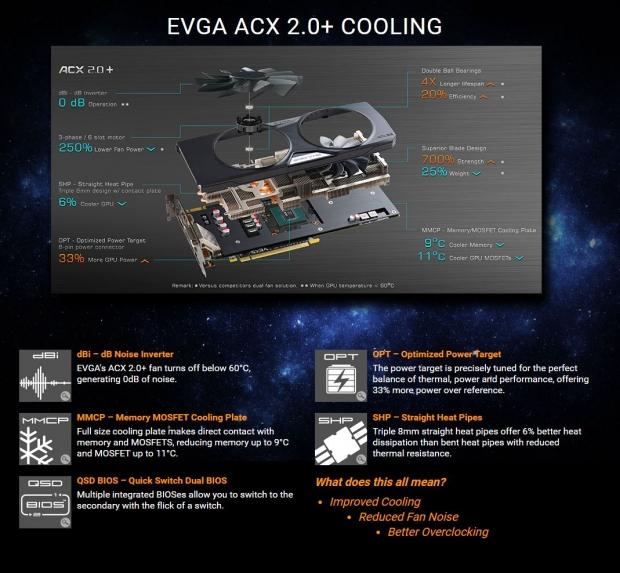
Now, let's dive into a look at the card itself.
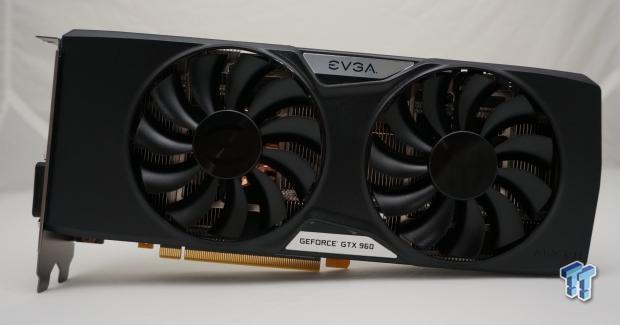
The front of the card is quite plain, with its ACX 2.0+ cooler front and center.
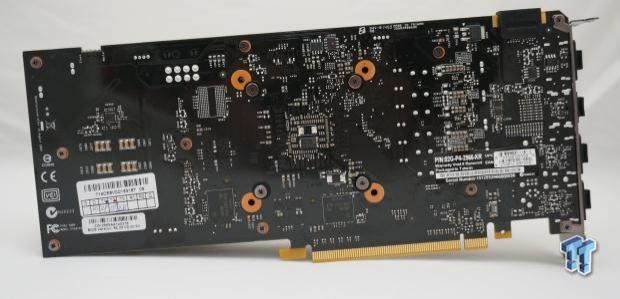
On the back of the card, we don't have back plate like we had on the ZOTAC GeForce GTX 960 AMP! Edition, so we'll see how hot the back of the EVGA GeForce GTX 960 SuperSC ACX 2.0+ gets during our testing.

On the very top of the card, we can see the well-crafted ACX 2.0+ cooling as well as the 8-pin PCIe power connector to the right. The previous GTX 960 AMP! Edition which we tested from ZOTAC had a 6-pin connector, so it'll be interesting to see how this EVGA card goes in our testing.
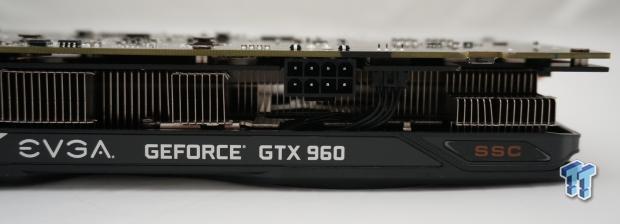
A slightly closer look at the 8-pin PCIe power connector, and the ACX 2.0+ cooling.
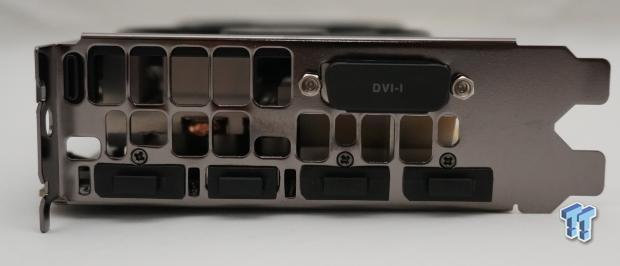
The rear of the card, where we have our various display outputs, including three DisplayPort, one HDMI 2.0 and one dual-link DVI.
Card Specifications & Cooling Setup
Card Specifications
With four cards in its GTX 960 lineup, the SuperSC AX 2.0+ is the third best of them. We have the awesome ACX 2.0+ cooling, as well as the great overclock over the reference GTX 960 specifications. The "ultimate" card is the GTX 960 FTW ACX 2.0+, which has slightly higher Base and Boost clock speeds.

As you can see, we have 1279/1342MHz for the Base/Boost clocks respectively, while the FTW ACX 2.0+ version of the card cranks it up to 1304/1367MHz for Base/Boost respectively.
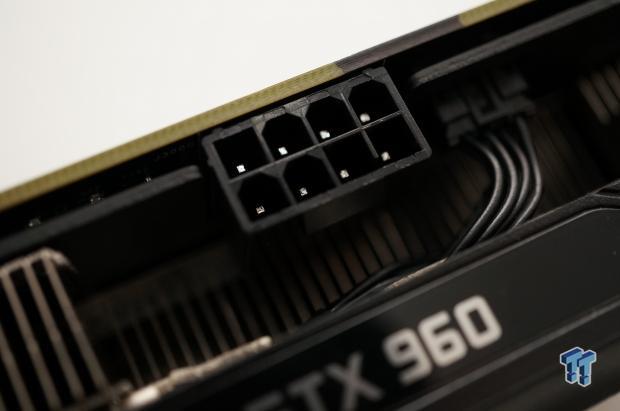
The 8-pin PCIe power connector is going to provide the card with more power than its 6-pin competitors, but by how much? We should see a decent performance increase over some of the competing cards, and as we pump out more reviews, we'll see a better picture of which is the best GTX 960 on the market. EVGA definitely has a huge fighting chance with this GTX 960 SuperSC ACX 2.0+.
Cooling Setup
EVGA's impressive ACX 2.0+ cooler looks even better in person than it does in the photos, with the company putting in some serious engineering efforts into the ACX 2.0+ design, and performance. The cooler can be broken down into various parts, which all play their various roles in making the ACX 2.0+ perform as well as it does.

As you can see in the image above, EVGA is using double ball bearings, which last for up to 400% longer than sleeve bearing fans that competing cards use. EVGA states that "the oil that is used in Sleeve bearing fans makes them vulnerable and prone to failure after time when the oil dries up".

Then we have the ACX 2.0+ cooler, which uses "over 4X lower power than competitor's allowing for better and more stable overclocks". Overall, EVGA has the best cooling on a GTX 960 we've used to date, with its so-far-very-impressive ACX 2.0+ cooling.
Testing Method & Test System Configuration
Note - Lack of Video Cards
Because I'm only just starting out as TweakTown's Video Card Editor, I don't have a slew of GPUs to test with as yet. As our reviews of the GeForce GTX 960s continue into the coming weeks, I have other GPUs on the way. I can then throw in some numbers from AMD Radeon cards - but for now, we're only looking at the GeForce GTX 780 and GTX 980 both in reference form directly from NVIDIA, the ZOTAC GeForce GTX 960 AMP! Edition we reviewed last week, and the EVGA GeForce GTX 960 SuperSC ACX 2.0+ we have here to review today.
Testing Method
Because I'm just starting out reviewing GPUs, we're going to slowly evolve our benchmarking setup. I'm not going to dive into the deep end and start testing out real-time FPS, as this will hurt the quality of the reviews. Instead, I'd like to nail these initial reviews and then we can start doing real-time numbers of games like Far Cry 4 and Star Citizen. However, I've played Battlefield 4 on a 64-player server to provide some real-world performance numbers.
For now, I'm going to be using the same suite of benchmarks I've been using on my Tweakipedia articles, which uses a mix of synthetic benchmarks with Futuremark's 3DMark and Unigine Heaven. After that, we have a bunch of titles with built-in benchmarks (which does not represent actual in-game performance), but they are repeatable for you at home to gauge the performance of your PC or video card.
Over time, I will be adding in new benchmarks and a new section that will concentrate solely on real-time gaming benchmarks. This will take more time per review, as I'll have to invest time into actually physically playing the games, but it'll be worth it in the long run. For now, let's get right into the synthetic benchmarks and see how this EVGA GeForce GTX 960 SuperSC ACX 2.0+ performs.
Something Different
Most people purchasing this card are only going to be gaming at up to 1080p, as the 128-bit memory bus and 2GB of VRAM is going to severely limit and hinder performance above that resolution. 2560x1440 (1440p) and 3840x2160 (4K) are going to be resolutions that this card won't be used for (mostly). That's not to say that you won't purchase this card for it, but I would highly recommend that people looking to buy any of the GeForce GTX 960s to only get one if you have a 1080p capable monitor, and plan to not upgrade for a while.
Test System Configuration
We only recently built our new X99-powered system, something you can read about here. As for the detailed specifications, this is what we're running:
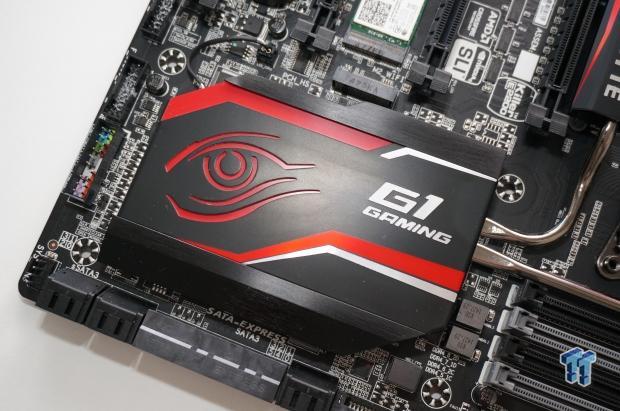
- CPU: Intel Core i7 5820K processor w/Corsair H110 cooler
- Motherboard: GIGABYTE X99 Gaming G1 Wi-Fi
- RAM: 16GB Corsair Vengeance 2666MHz DDR4
- Storage: 240GB SanDisk Extreme II and 480GB SanDisk Extreme II
- Chassis: Lian Li T60 Pit Stop
- PSU: Corsair AX1200i digital PSU
- Software: Windows 7 Ultimate x64
- Drivers: GeForce 347.25
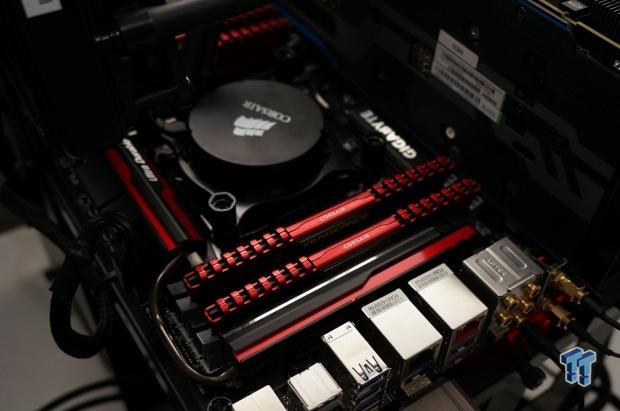
We're running the system at stock CPU speeds, which will provide more of a 'real-world' feel to our benchmarks. Sure, this isn't an i7-5960X at 5GHz, but what person is going to team up an incredibly expensive CPU with a mid-range GPU? Not many.
Our GPU tests are changing, shifting toward more of a real-world feel. But don't worry, we will be doing some crazy balls-to-the-wall tests that will see serious overclocks, Extreme Edition processors, and much more in the coming months. For the most part, we will be doing more real-world testing by teaming up the right processor with the right GPU in its price category.
Even still, most people would be running an LGA 1150 socket Core i5 or mid-range AMD FX-8350 with a GeForce GTX 960, so we're still giving it some better guts as a CPU.
Synthetic Benchmarks (3DMark and Heaven)
3DMark Fire Strike - 1080p
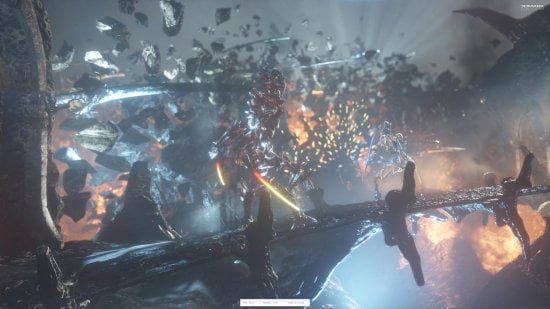
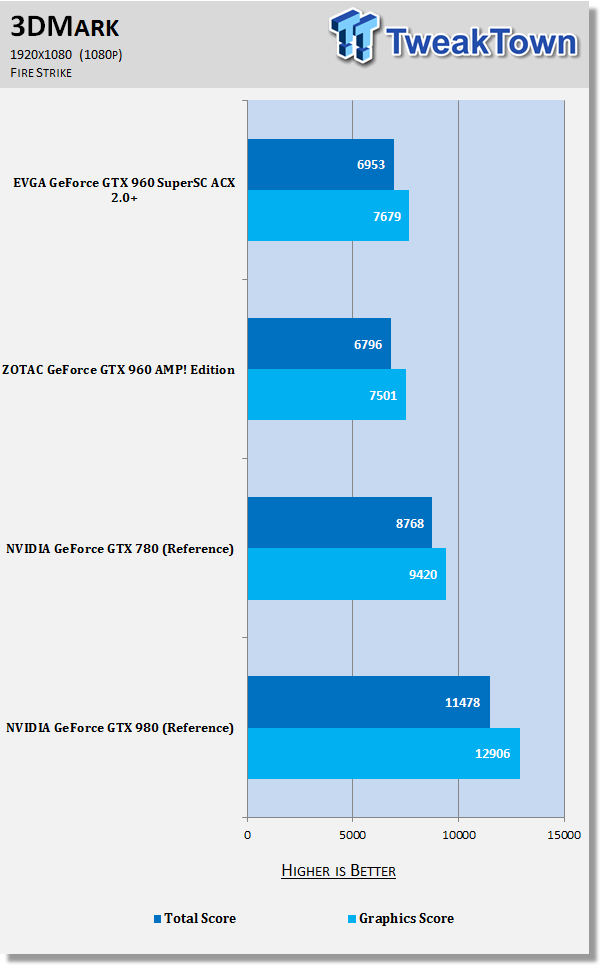
3DMark Fire Strike Extreme - 1440p
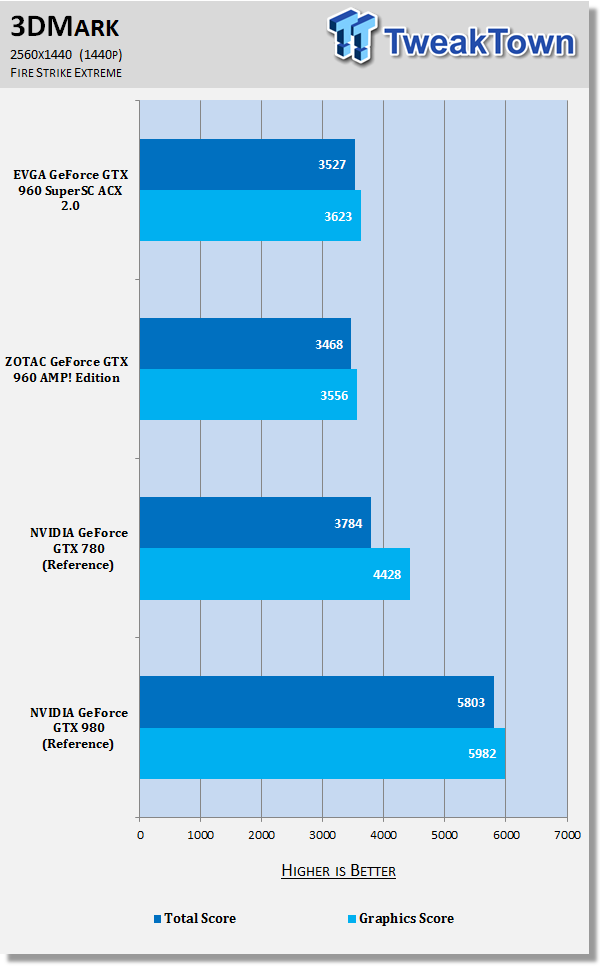
3DMark Fire Strike Ultra - 4K
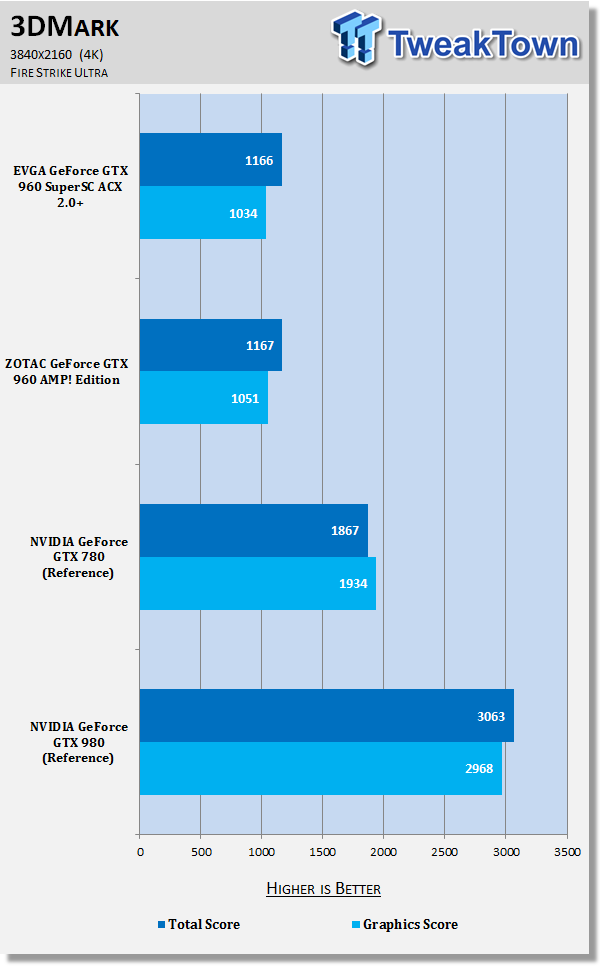
Heaven - 1080p
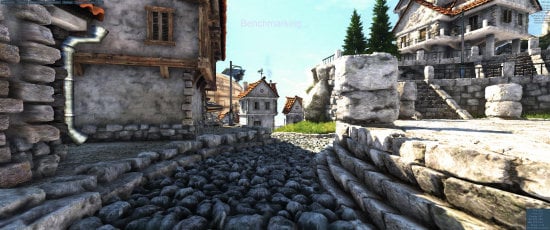
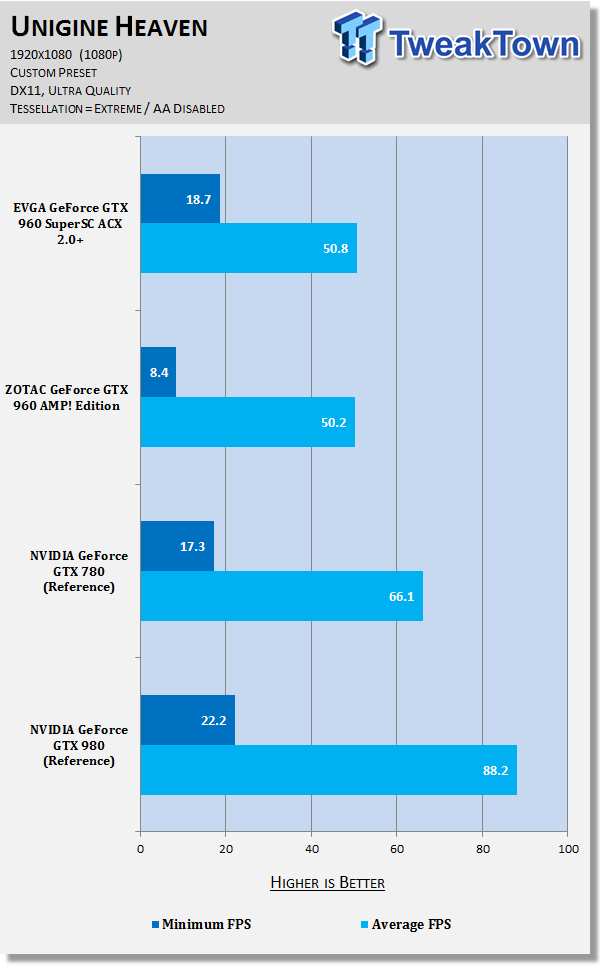
Heaven - 1440p
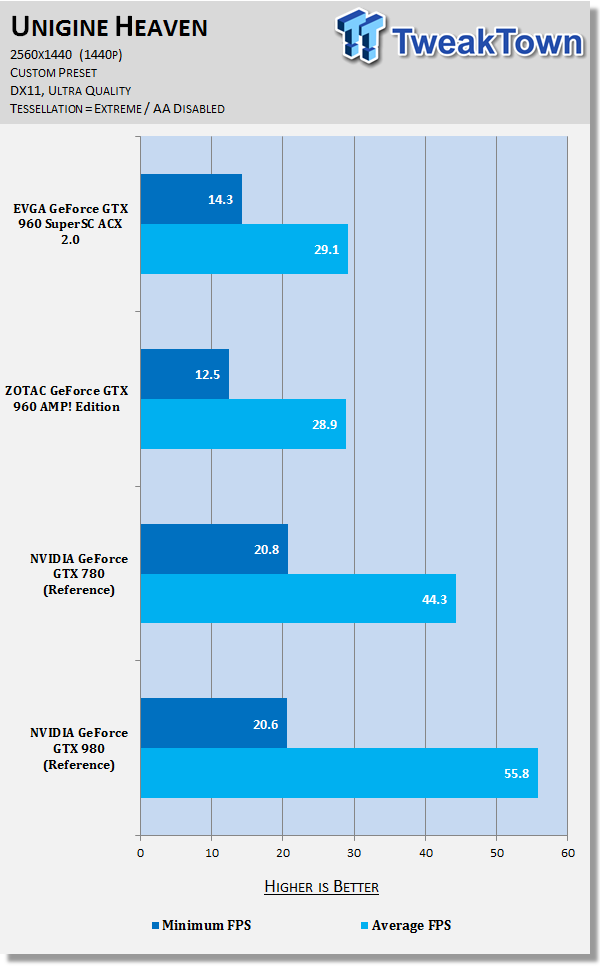
Heaven - 4K
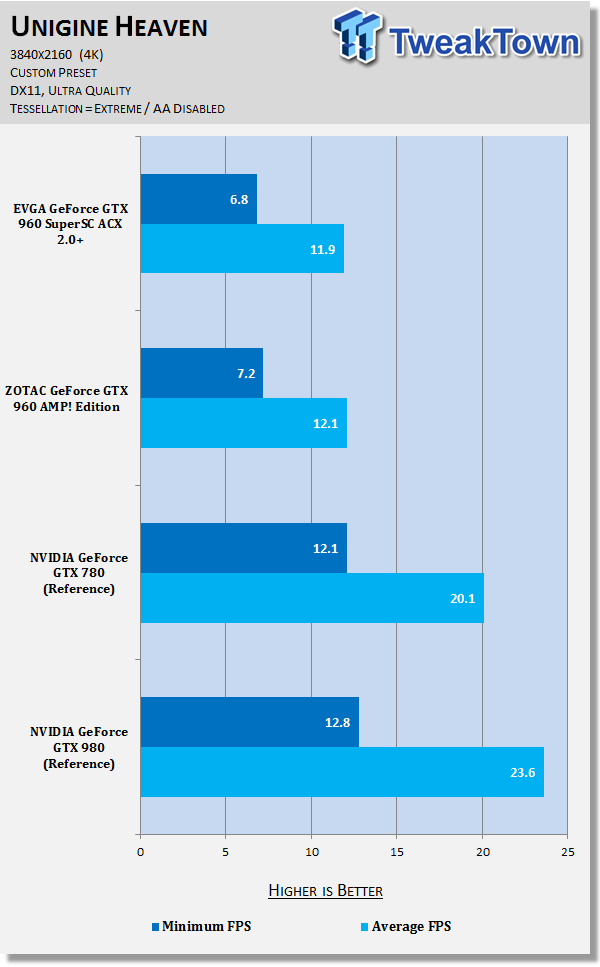
The EVGA GeForce GTX 960 SuperSC ACX 2.0+ performed slightly higher than the ZOTAC GeForce GTX 960 AMP! Edition, pushing out a total of 6953, up from the 6796 that the ZOTAC card managed. At 1440p, the total score on the EVGA card was 3527, while the ZOTAC was slightly behind at 3468. At 4K, both cards struggle, with the EVGA GeForce GTX 960 SuperSC ACX 2.0+ managing to lose out to the ZOTAC card by a single digit.
Unigine Heaven is a stressful test, but the Maxwell-powered GTX 960 performs well under this test. EVGA managed an average of 50FPS, identical to that of the ZOTAC card, but with a higher minimum frame rate of 18FPS compared to 8.4FPS.
At 1440p, the EVGA GeForce GTX 960 SuperSC ACX 2.0+ was pushing the same numbers as the ZOTAC card, with 14.3FPS minimum compared to 12.5FPS minimum. Average results were identical, at 29.1FPS to the EVGA card, and 28.9FPS to ZOTAC.
At 4K, the results are identical once again. We have 6.8FPS minimum for the EVGA GeForce GTX 960 SuperSC ACX 2.0+, while the ZOTAC GeForce GTX 960 AMP! Edition is slightly better with 7.2FPS. Average FPS wise, the EVGA card managed 11.9FPS, while ZOTAC beat it, just, at 12.1FPS.
Game Benchmarks (1080p)
Battlefield 4
This is one game that we did differently, as it does not feature a built-in benchmarking feature. When it comes to Battlefield 4, there are countless ways you can benchmark it. Some find a spot in the single player campaign which is easily repeatable, and use that. For our testing, we've chosen to use a 64-player online multiplayer server for real-time performance statistics.
We joined a 64-player map and played for five minutes using FRAPS, pulling our minimum/average and maximum FPS. We did this for each test, running 1080p at Medium/Ultra and then 1440p at Medium/Ultra - but for the 1440p tests, we disabled AA as it is quite stressful on the GPU at that resolution. We're only doing this to give you a look at what BF4 performance is like on the GTX 960 AMP! Edition, and 1440p with 4x MSAA isn't an ideal way of doing that.

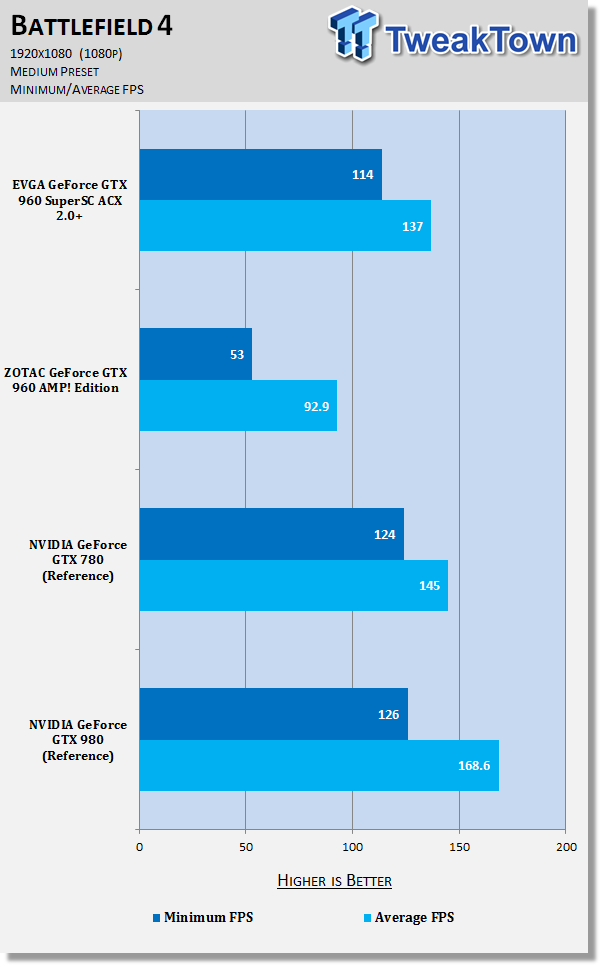
And again, this time with the Ultra preset.

GRID Autosport

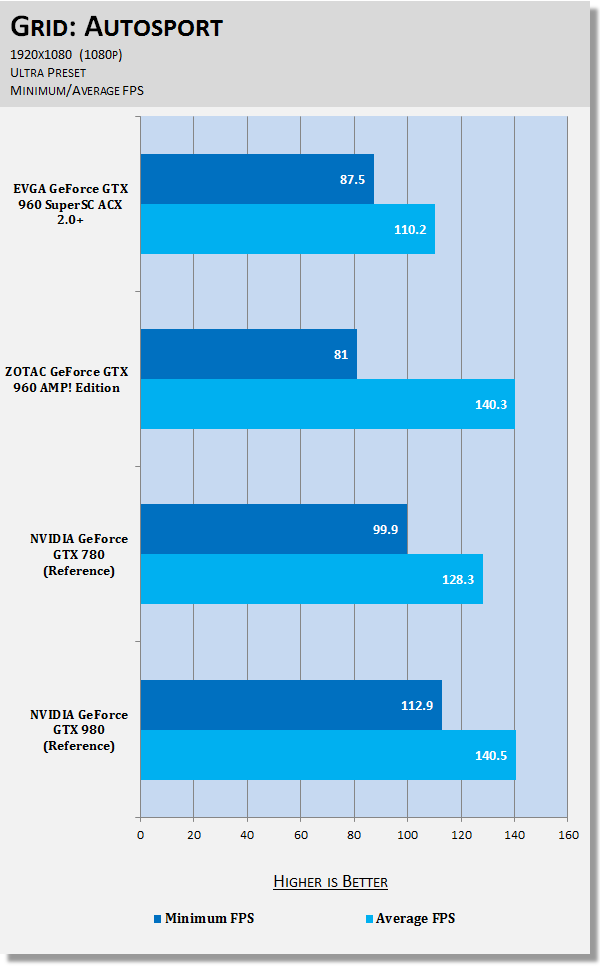
Metro: Last Light

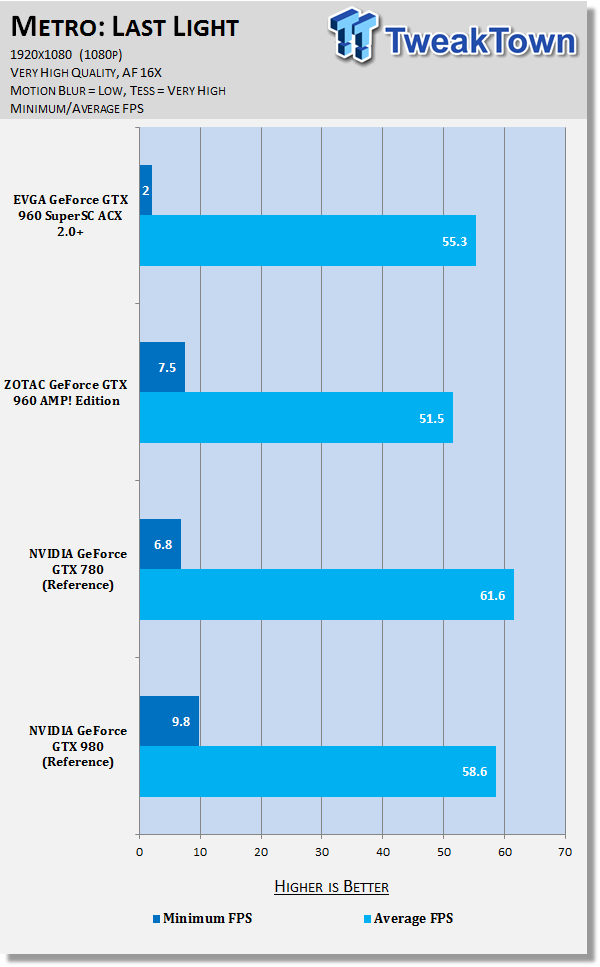
Middle-earth: Shadow of Mordor

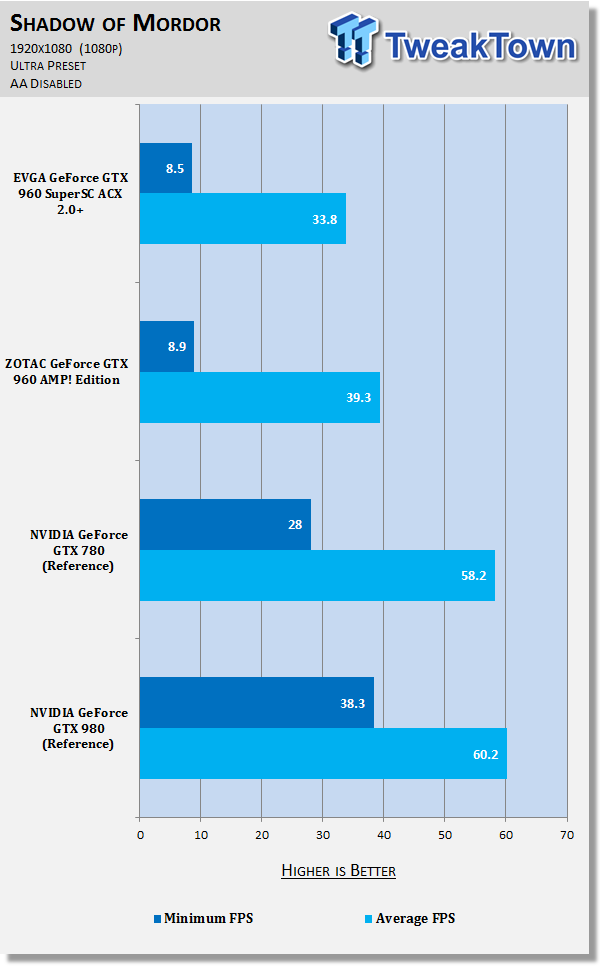
Thief


Sniper Elite 3
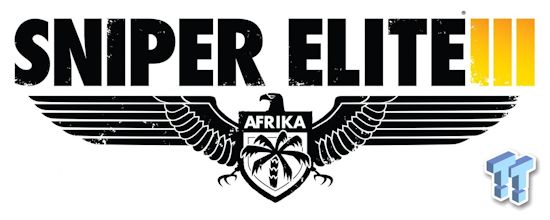
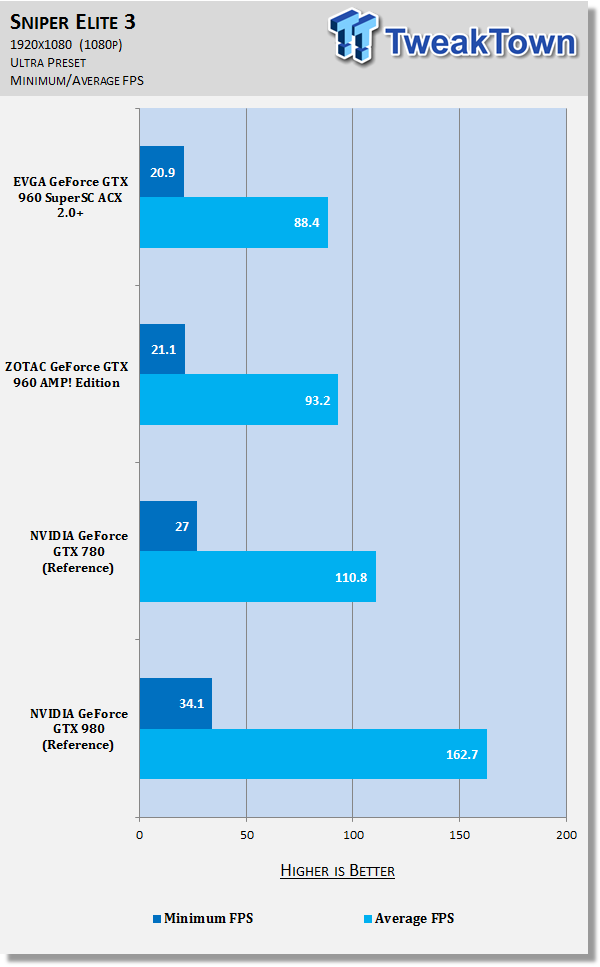
Tomb Raider

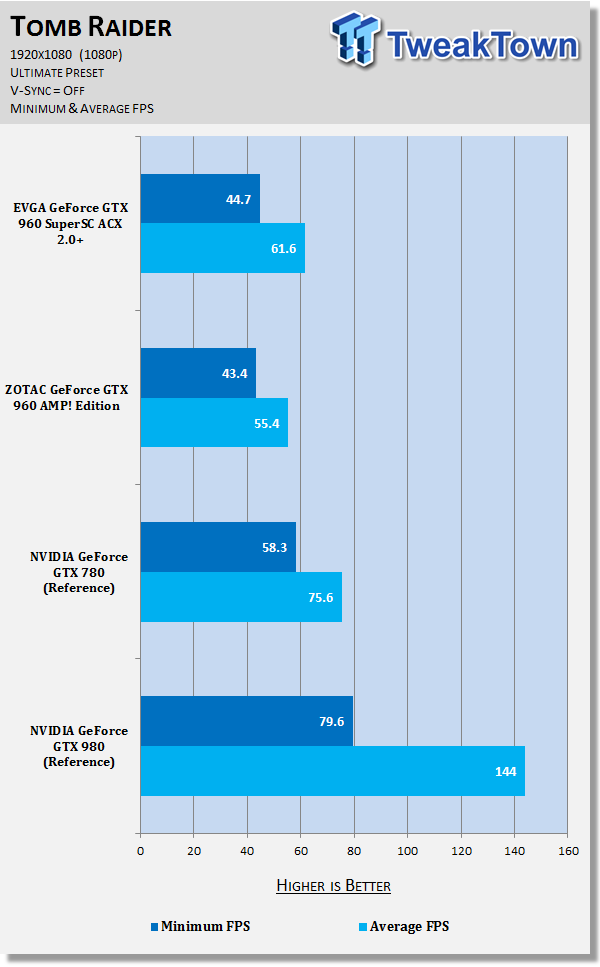
BioShock Infinite

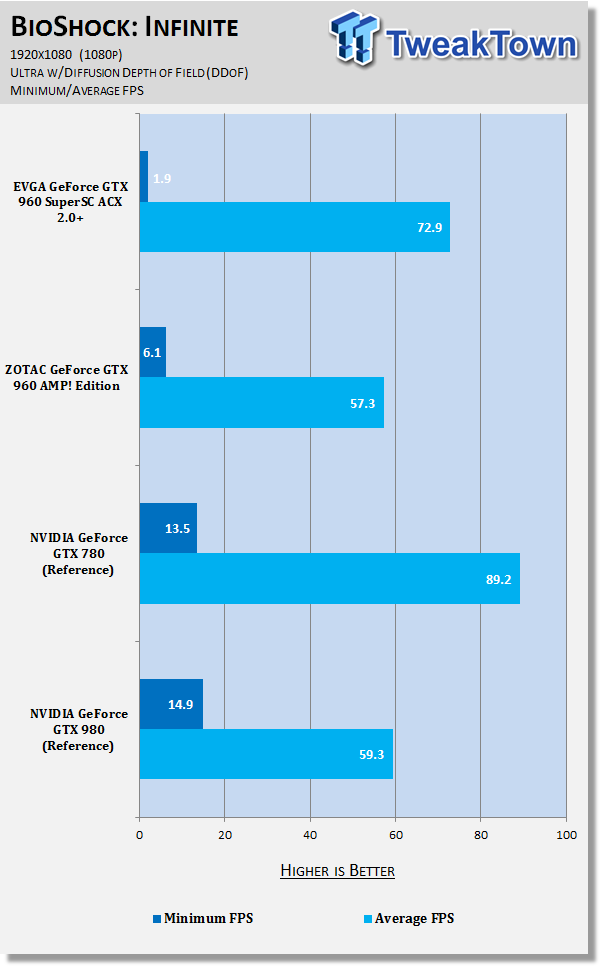
DiRT Showdown
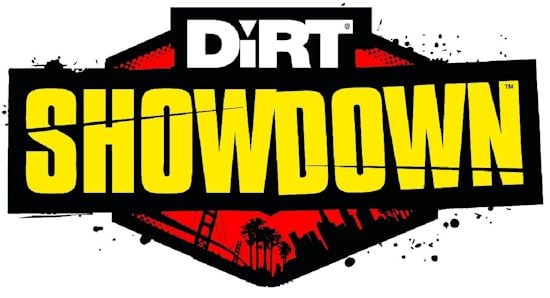
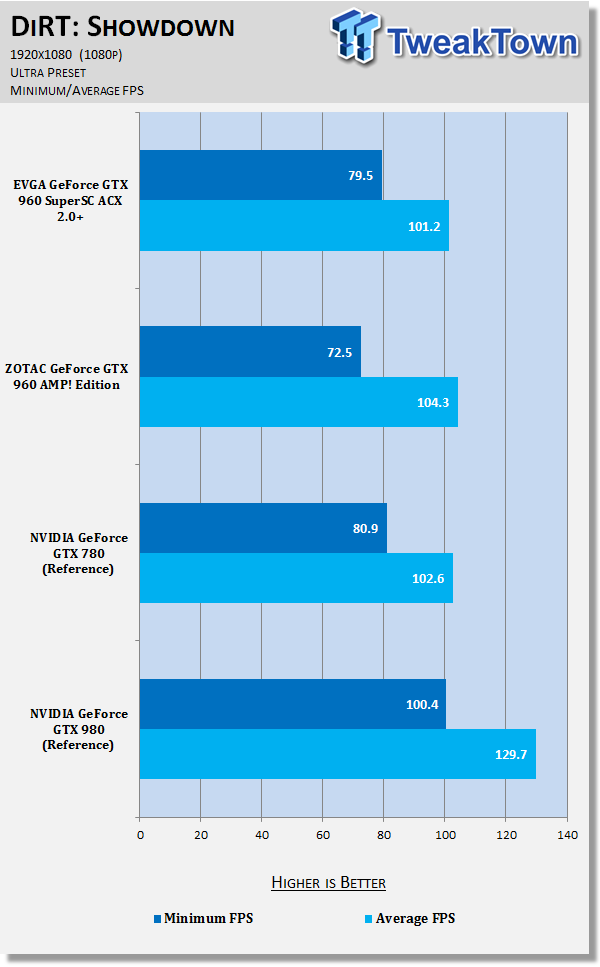
Batman: Arkham Knight
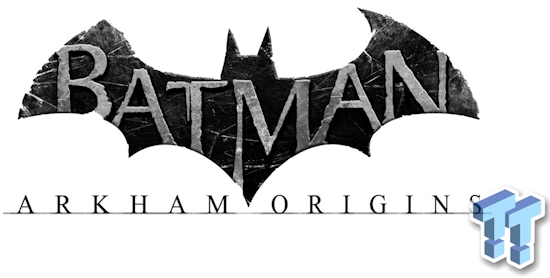
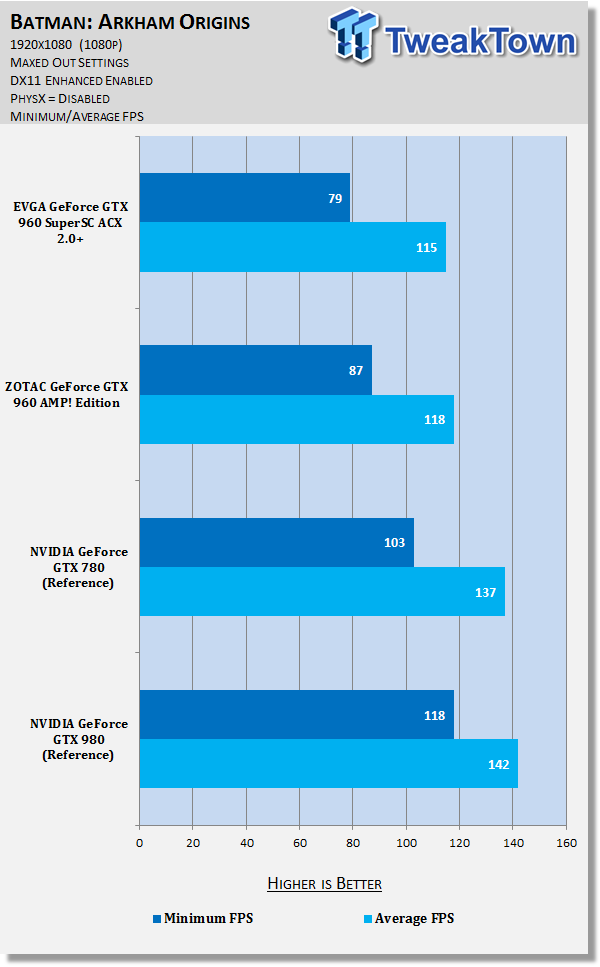
You can find our performance summary of all of our gaming tests later in the review.
Game Benchmarks (1440p)
Battlefield 4

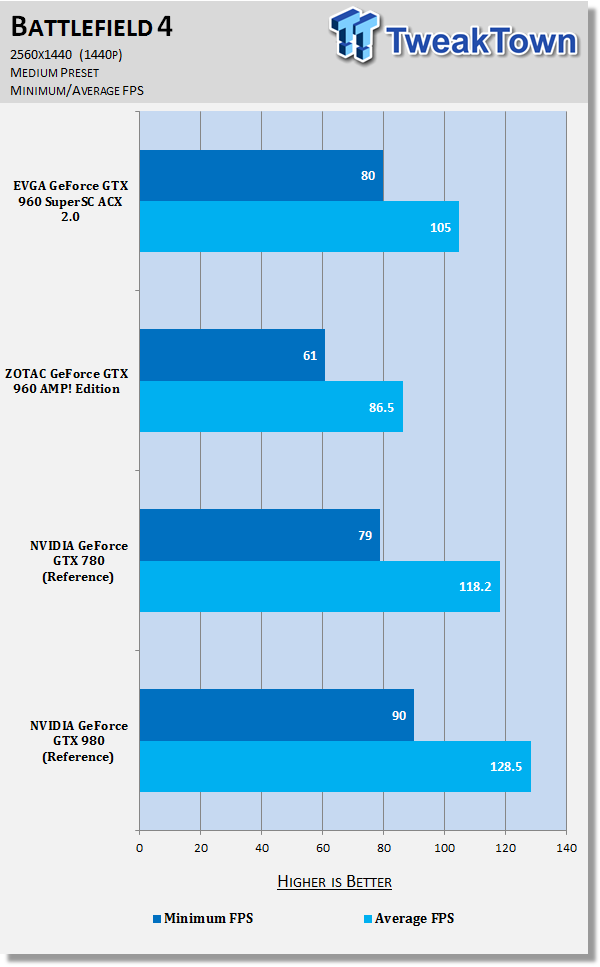
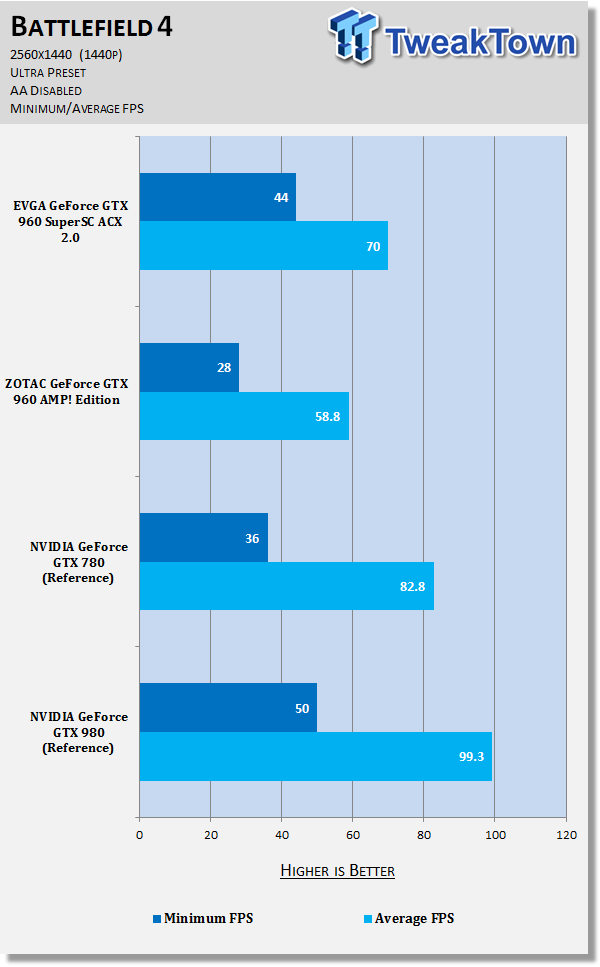
GRID Autosport

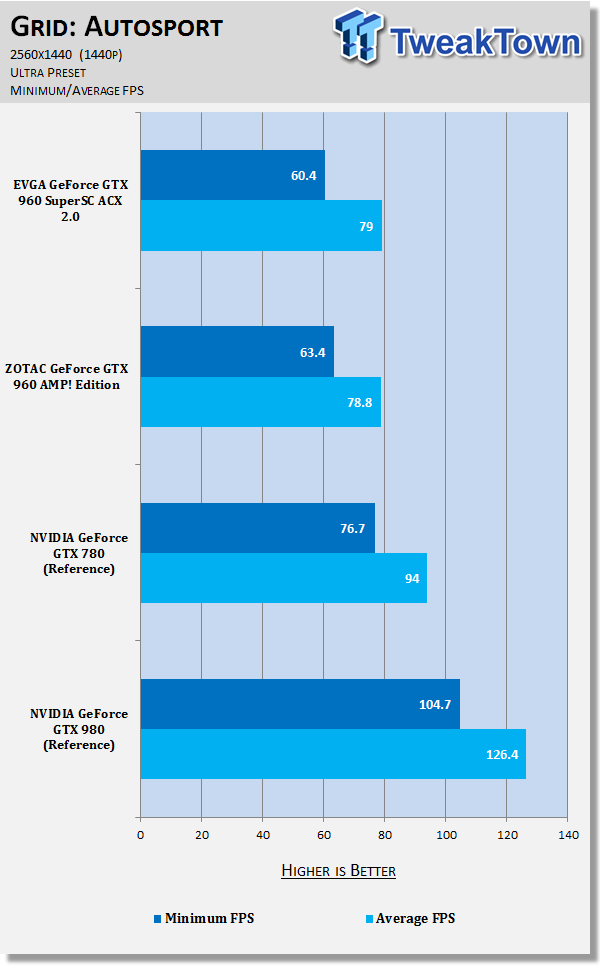
Metro: Last Light

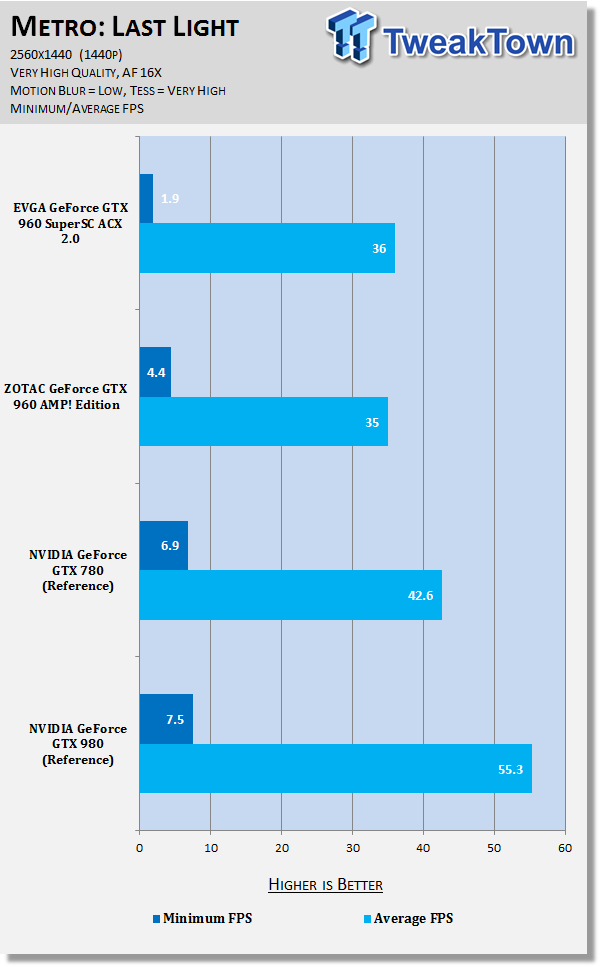
Middle-earth: Shadow of Mordor

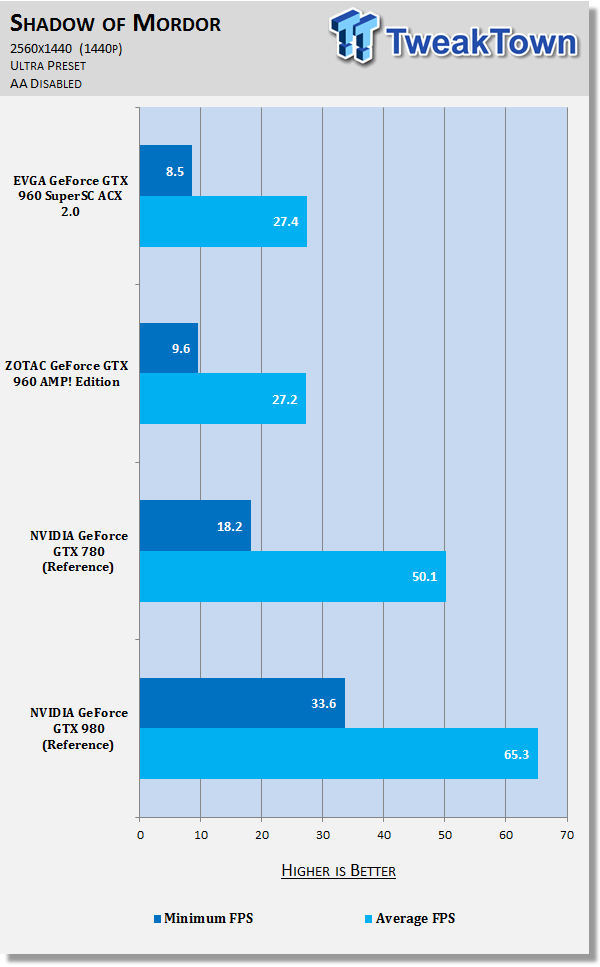
Thief

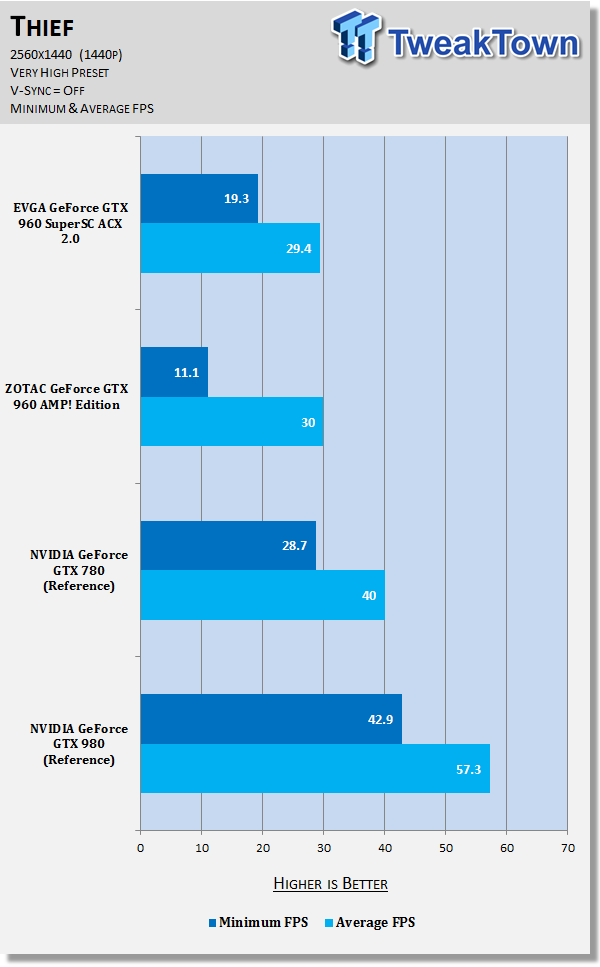
Sniper Elite 3

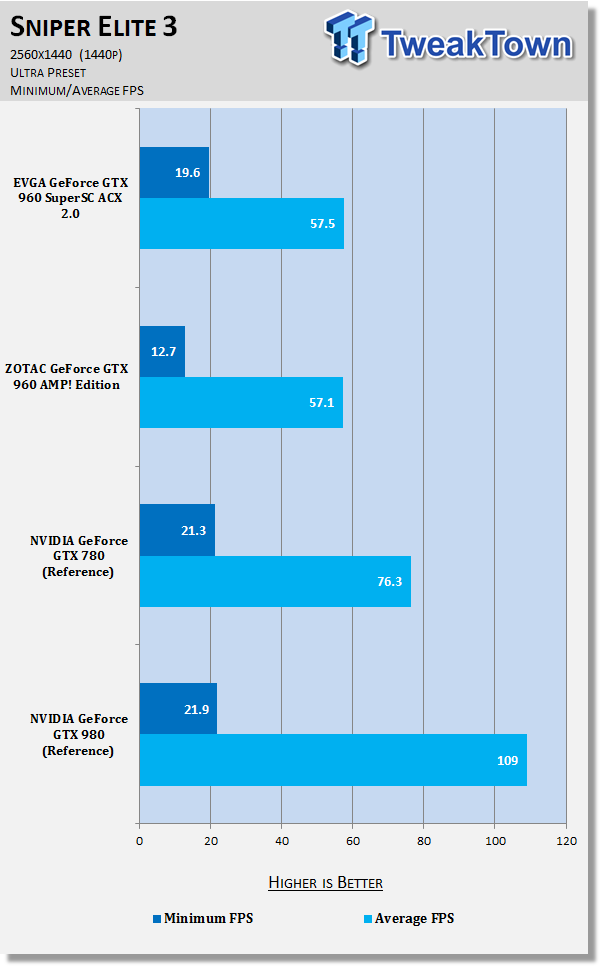
Tomb Raider

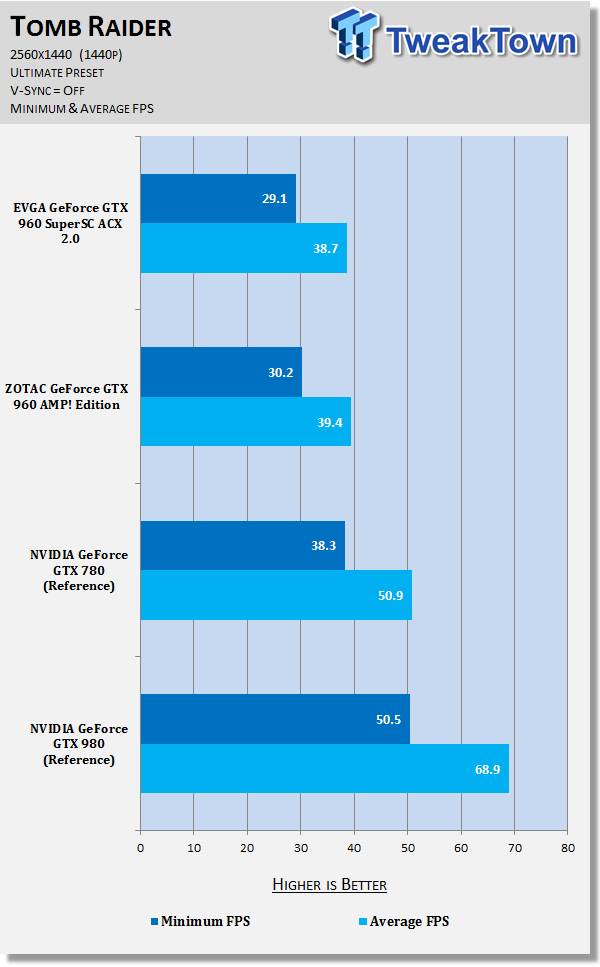
BioShock Infinite

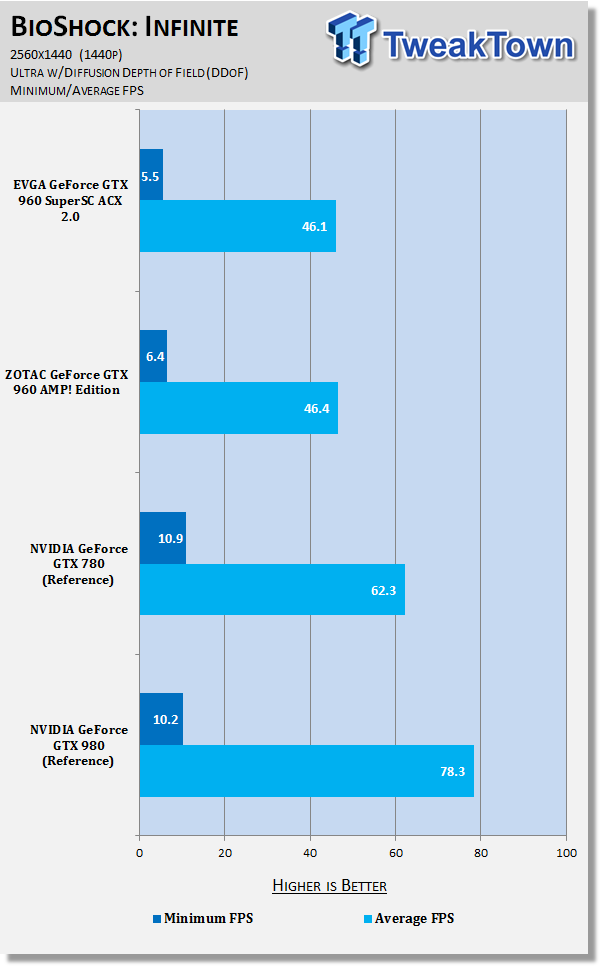
DiRT Showdown

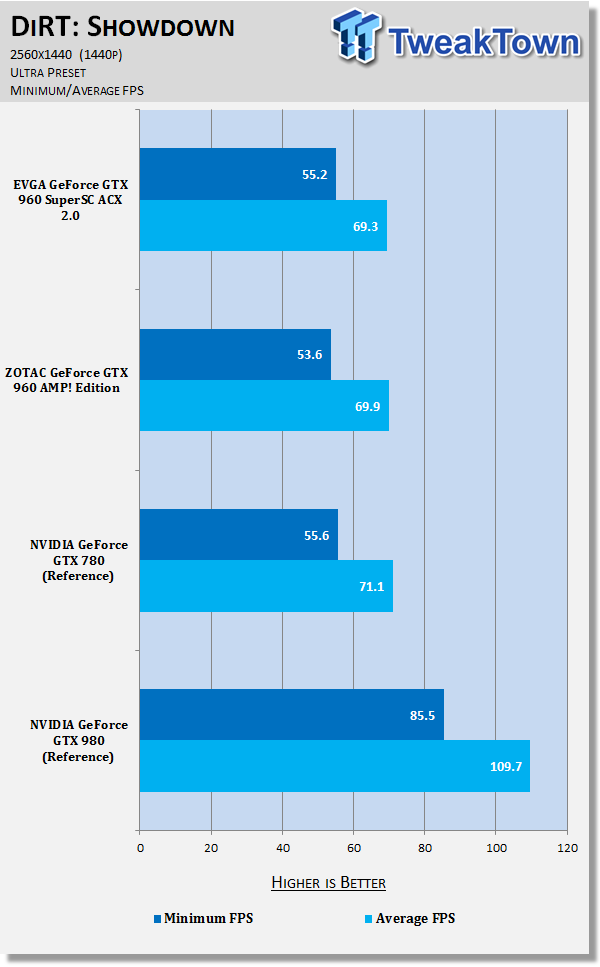
Batman: Arkham Knight

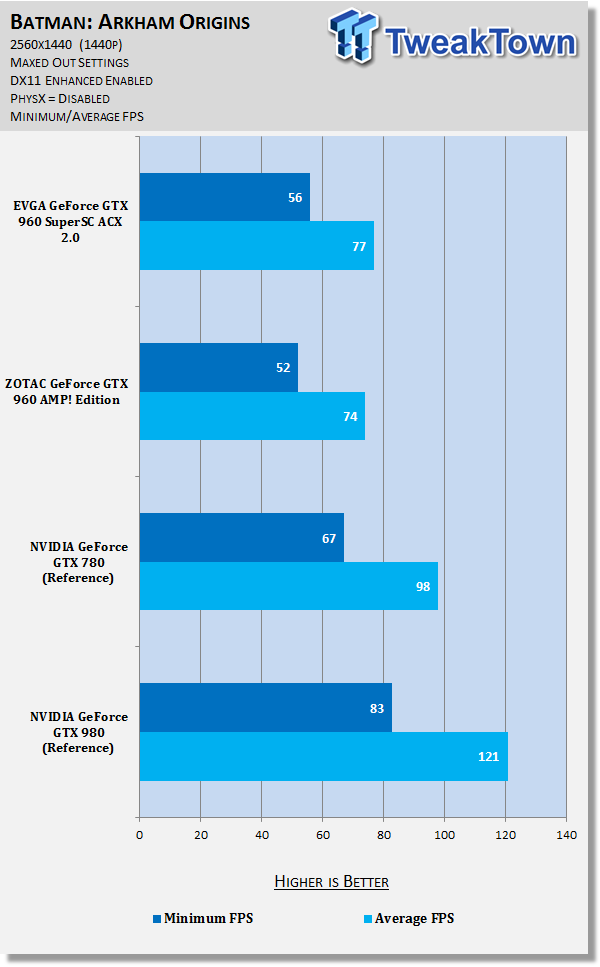
You can find our performance summary of all of our gaming tests later in the review.
Game Benchmarks (4K)
Battlefield 4

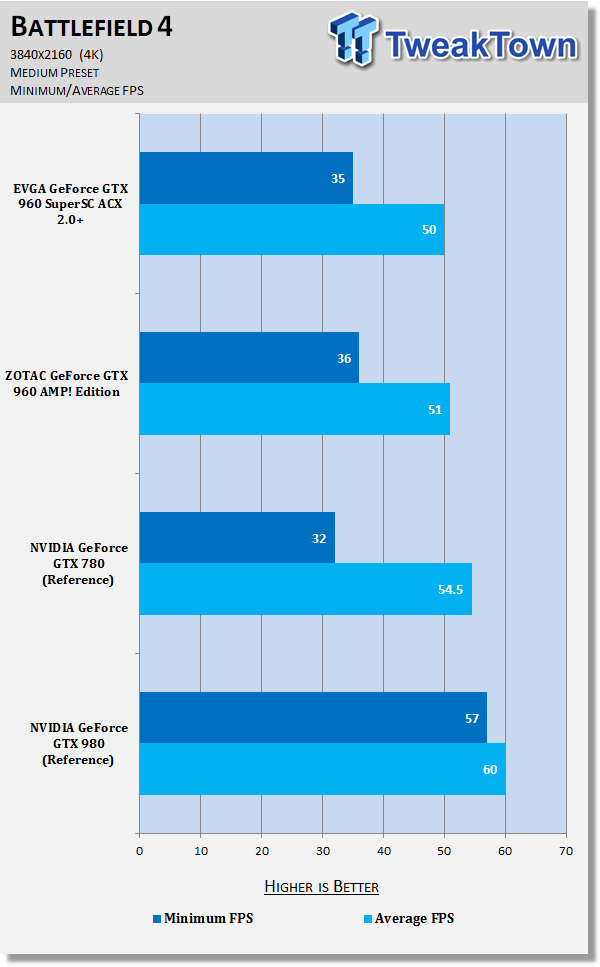
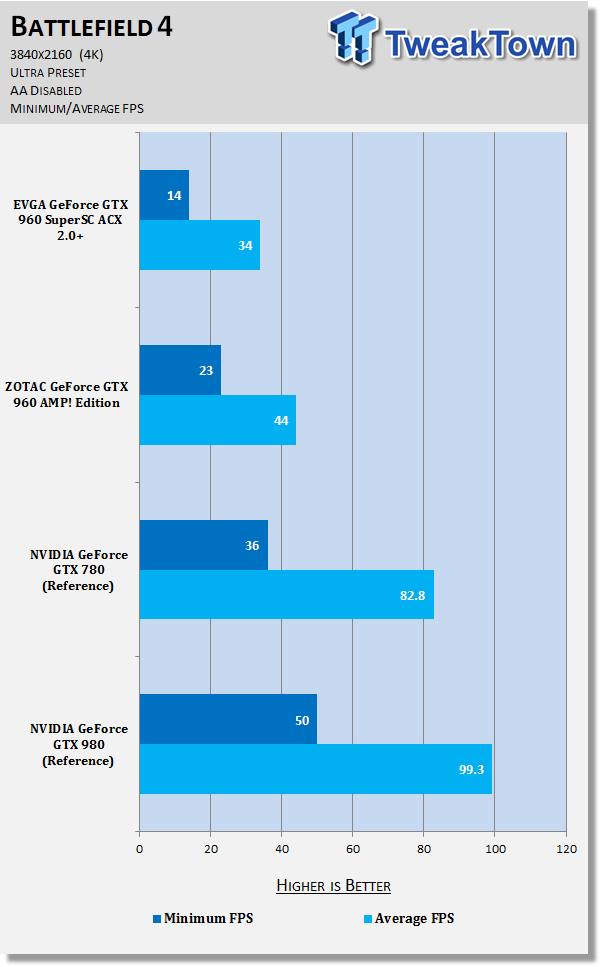
GRID Autosport

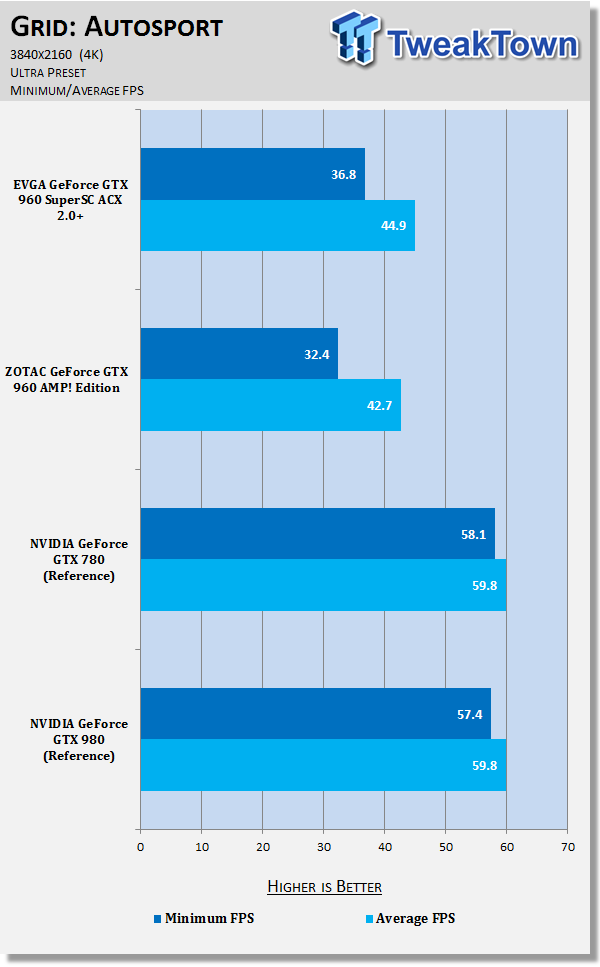
Metro: Last Light

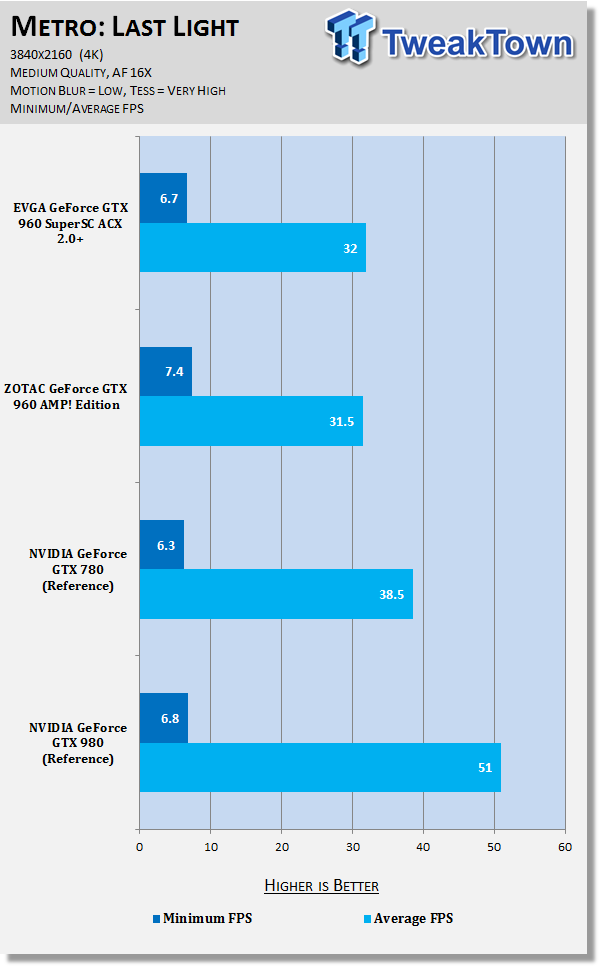
Middle-earth: Shadow of Mordor

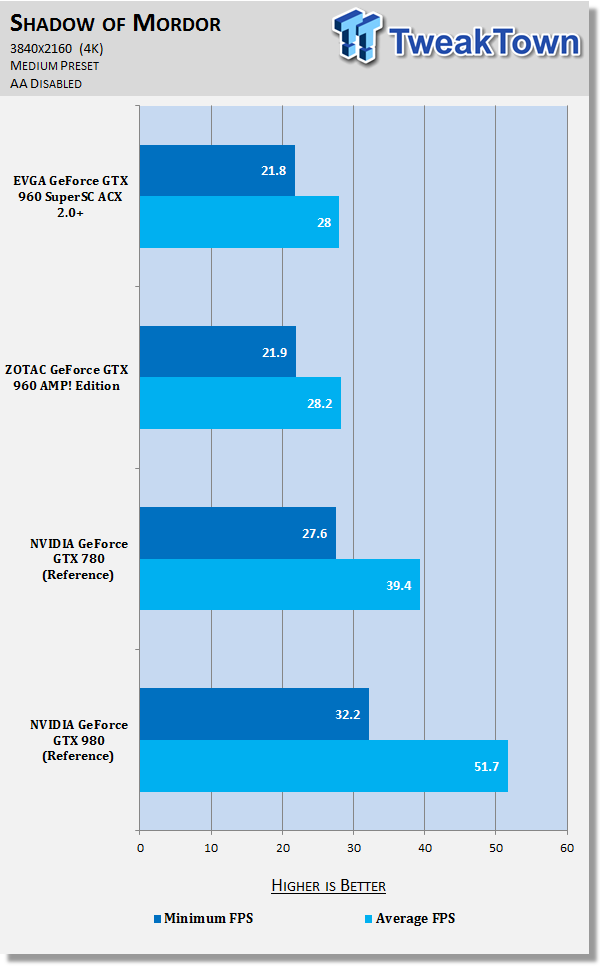
Thief

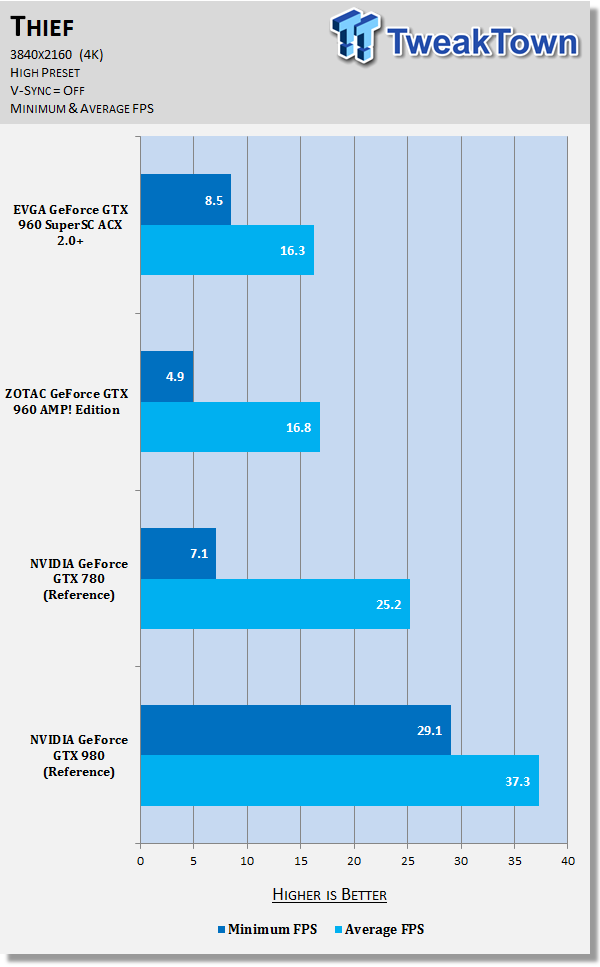
Sniper Elite 3

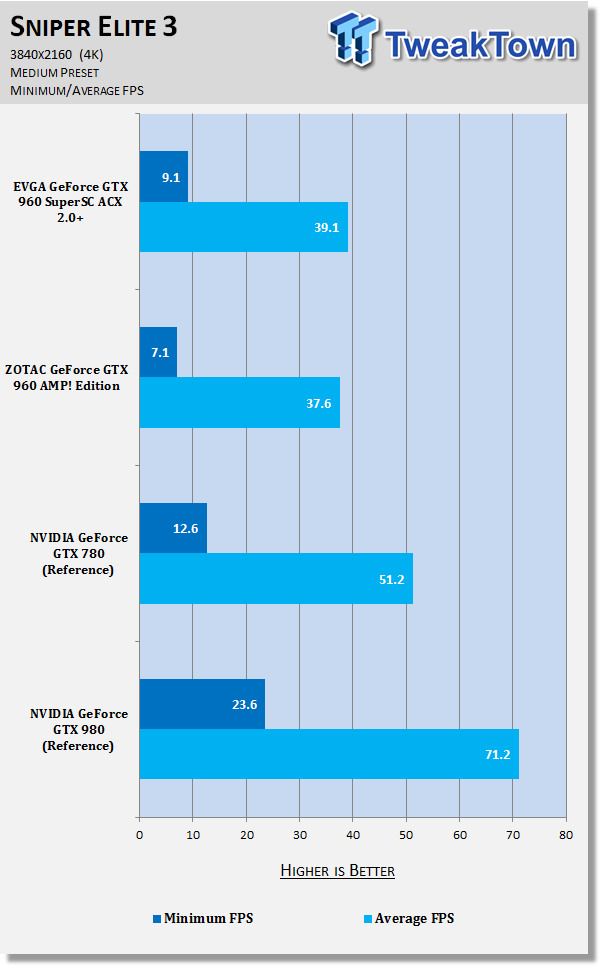
Tomb Raider

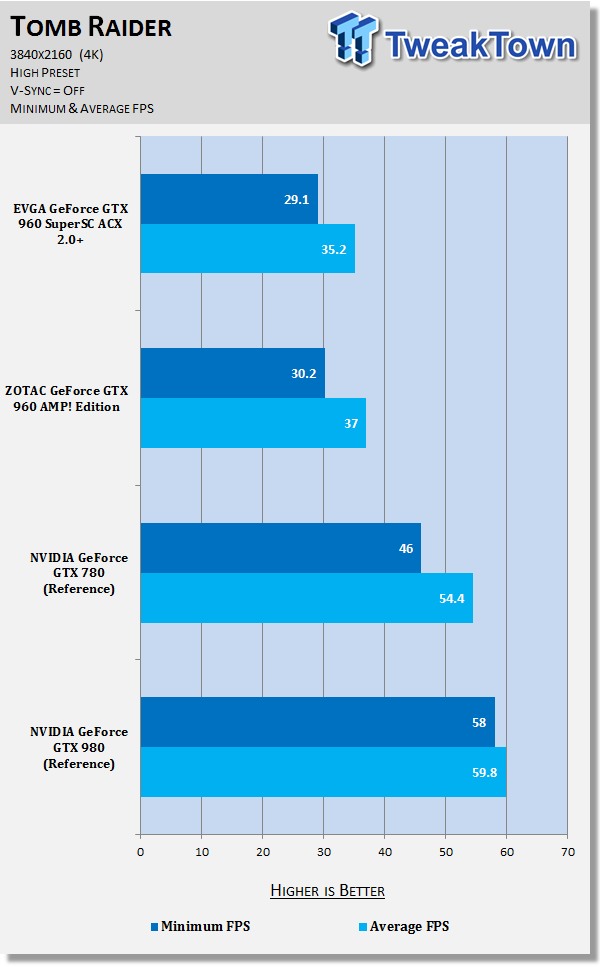
BioShock Infinite

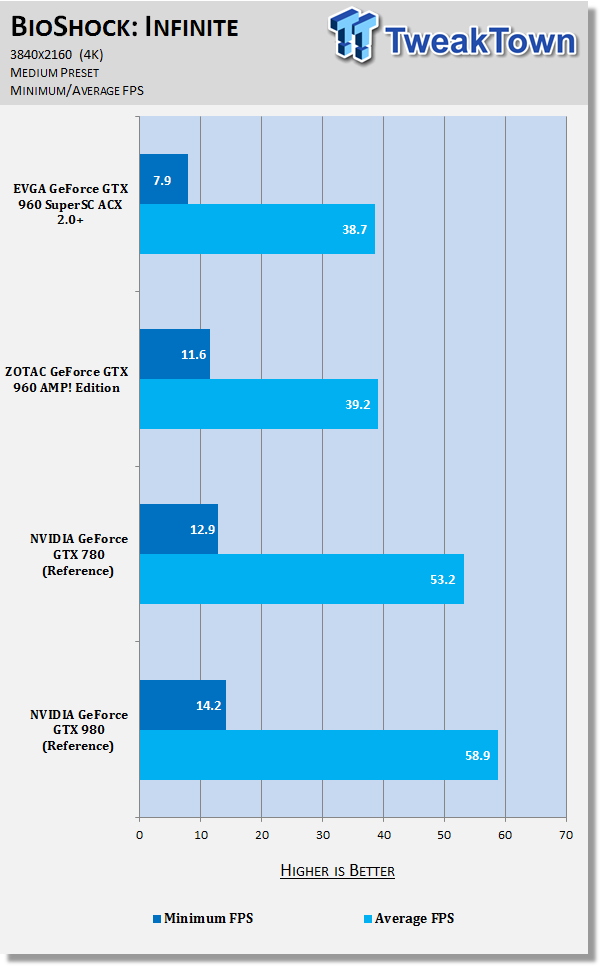
DiRT Showdown

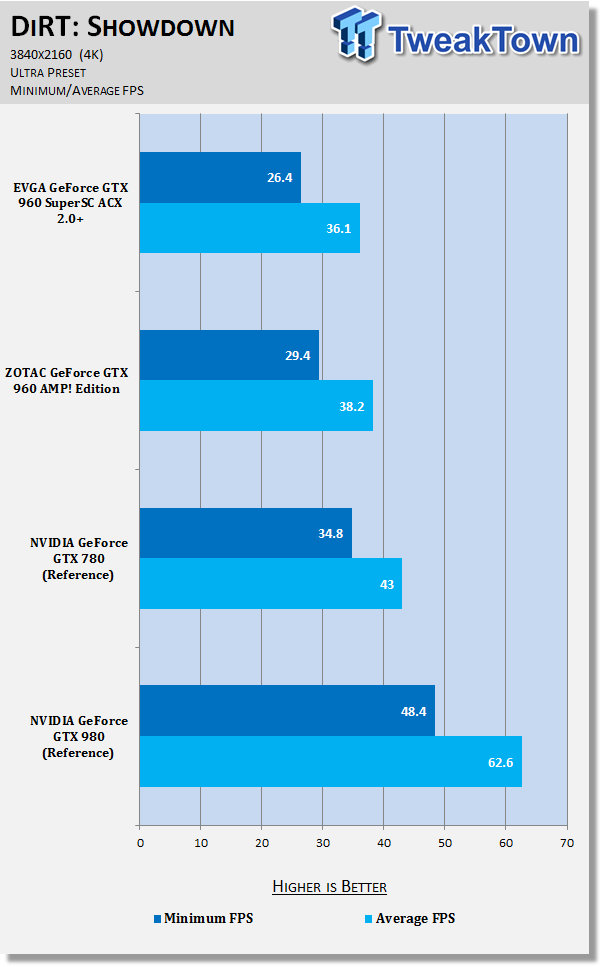
Batman: Arkham Knight

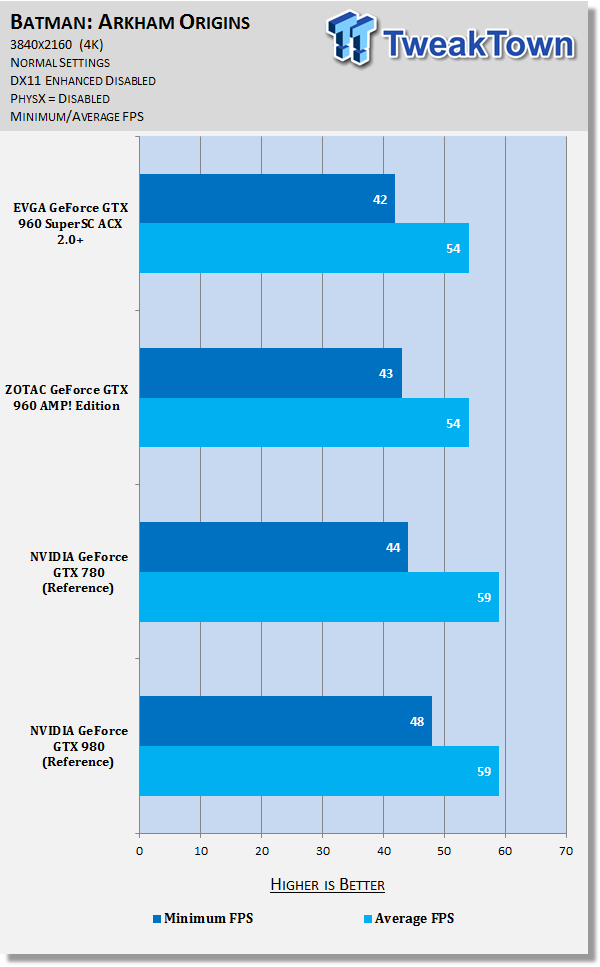
You can find our performance summary of all of our gaming tests later in the review.
Game Performance Summary
How We Judge Performance
To change up the usual way we used to review video cards, we will be looking at each card and judging its performance based on the resolution most people will be using it for. So when it comes to the EVGA GeForce GTX 960 SuperSC ACX 2.0+ most will be gaming at 1080p, but you're going to be surprised at the 2560x1440, or 1440p results.
I've obviously benchmarked the EVGA GeForce GTX 960 SuperSC ACX 2.0+ at 1440p and 4K, but those results will not be impacting my Final Thoughts on the card at all. Any and all judgment on this card is going to come from the 1080p benchmarking, its overclocking potential, features, software, noise, price and power consumption.
How does the EVGA GeForce GTX 960 SuperSC ACX 2.0+ stack up?
Before jumping into the numbers, we've only reviewed the ZOTAC GeForce GTX 960 AMP! Edition so far, with the EVGA GeForce GTX 960 SuperSC ACX 2.0+ being the second GTX 960 that we've taken a look at. Performance between them on our built-in benchmarks is within 5-10% of each other, so there's not much that's going to sell you in terms of performance for the EVGA card.
What will impress you is that it's totally silent, but that's not to say the ZOTAC card was, but the EVGA's ACX 2.0+ barely turns on, even when stressing it out at 4K.
Performance at 1080p
At 1920x1080, the EVGA card performs beautifully. We were able to play Battlefield 4 at 1080p and Ultra detail (AA disabled) at a minimum of 82FPS and an average of 107FPS. These results are great, and something that you simply cannot beat for $209.
Games like GRID Autosport ran great too, with 110FPS average, while Shadow of Mordor is just playable at 33FPS with its Ultra preset enabled (and AA disabled once again). Sniper Elite 3 was pushing out a great 88FPS average, while Lara Croft was enjoying her time in Tomb Raider with an average of 61FPS.
Performance at 1440p
We begin seeing a trend here with Battlefield 4 and the EVGA GeForce GTX 960 SuperSC ACX 2.0+ video card, where the average FPS really kills the ZOTAC GeForce GTX 960 AMP! Edition. The EVGA card managed 105FPS on the Medium preset at 1440p, while the ZOTAC card provided just 86FPS.
Turning things up a notch to the Ultra preset (minus AA), we see the EVGA card continue to shine with 70FPS, leaving the 58FPS result from ZOTAC in its dust. Not only that, but the minimum results are also much more impressive. We have the EVGA card giving us 44FPS minimum with Ultra settings at 1440p, while the ZOTAC card was only managing 28FPS.
As for the rest of our games, GRID Autosport found identical results to that of the ZOTAC card, while Metro: Last Light saw the EVGA GeForce GTX 960 SuperSC ACX 2.0+ spitting out 36FPS, just one more frame compared to the 35FPS on the competing GTX 960. Shadow of Mordor had the same 27FPS, while our remaining four tests netting us nearly identical results to that of the ZOTAC card.
Performance at 4K
The EVGA GeForce GTX 960 SuperSC ACX 2.0+ performs quite well at 4K, but this isn't something you'd be buying it for. Starting with Battlefield 4 at Medium settings, we actually see some impressive results with 50FPS average, identical to that of the ZOTAC variant.
GRID Autosport, Metro: Last Light and Shadow of Mordor had nearly identical results to that of the ZOTAC GeForce GTX 960 AMP! Edition, with the rest of our games in our benchmarking lineup resulting in nearly the same performance. The GTX 960, no matter what stock (out of the box) speeds on offer, is within 5-10% of the performance of any model close to it.
Overclocking
Overclocking, With Precision
Overclocking these GeForce GTX 960s isn't netting much performance gains, but we continued to push through anyway. From what I've been playing around with, you can get around 5-10% performance improvement with an overclock, which isn't too bad at all.
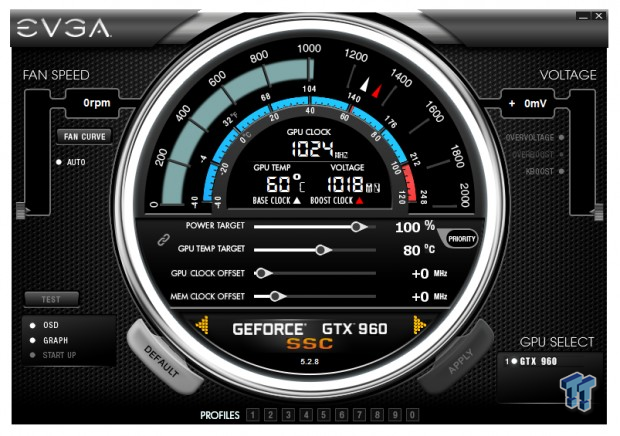
We opened up EVGA's PrecisionX software and began playing around with the GPU and Memory clocks on the GeForce GTX 960 SuperSC ACX 2.0+ card. From the default 1279MHz on the GPU, we were able to get up to 1420MHz stable. On the memory side of things, we were able to jump from 1753MHz default on the RAM to 1873MHz.
During our testing in Battlefield 4, we couldn't tell any difference between stock and overclocked when playing, but the frame rate did go up by around 6-7% from 88FPS to 94FPS at 2560x1440 with the Medium preset.
Power Consumption and Sound Testing
Power Consumption
Power efficiency is something that NVIDIA's Maxwell architecture delivers in droves. We saw a total of around 235W consumed (total system power, from the wall) with ZOTAC's GeForce GTX 960 AMP! Edition, but how do we see the EVGA faring in this test?
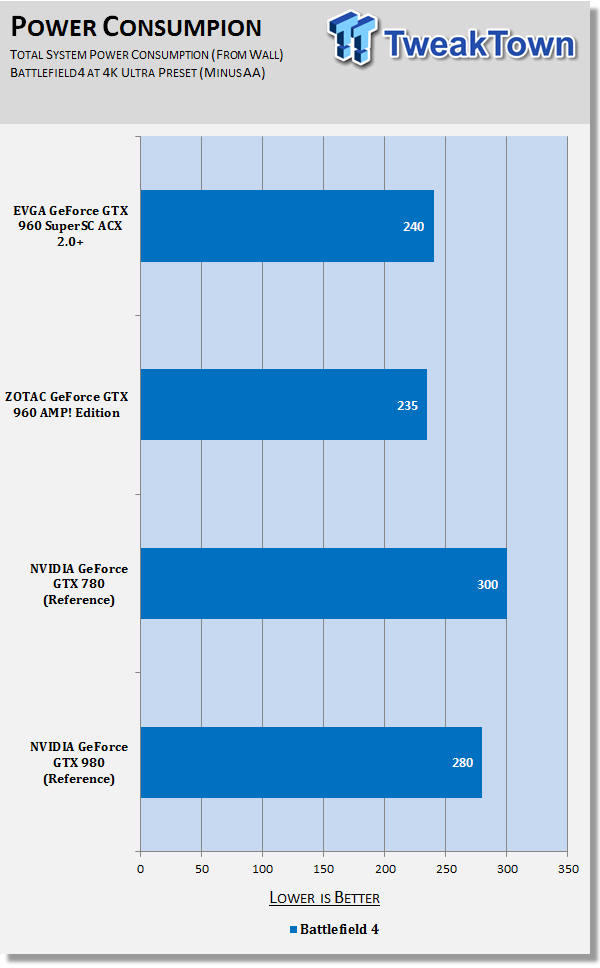
With the 8-pin PCIe power connector, the EVGA GeForce GTX 960 SuperSC ACX 2.0+ consumes no additional power (well, 5W) than the ZOTAC variant. This is great, as it means that we're still looking at less than 250W for 99% of people using this card, unless you take overclocking into account.
At idle, our entire system was consuming just 77W of power.
Sound Testing
Sadly sound testing was not available for this review, but it will be added soon for future reviews.
Software
EVGA includes its own PrecisionX overclocking software, but I decided to grab the latest version through Steam as it makes it easier to have everything in the one place. Downloading it just took a few seconds and I was ready to begin overclocking my flashy new GeForce GTX 960 SuperSC ACX 2.0+.

If you haven't seen EVGA's PrecisionX software, this is what the opening screen will provide you. On the left, we have fan speed, and on the right, we have voltage. To the bottom right, we can select another GPU if you had a second or third card in there for SLI.
In the middle, you can select various things to play around with such as Power Target, GPU Temp Target, GPU Clock Offset and Memory Clock Offset. Up the top, is the most obvious part - the speedometer-like look at your temperature, clock speeds, and voltage.
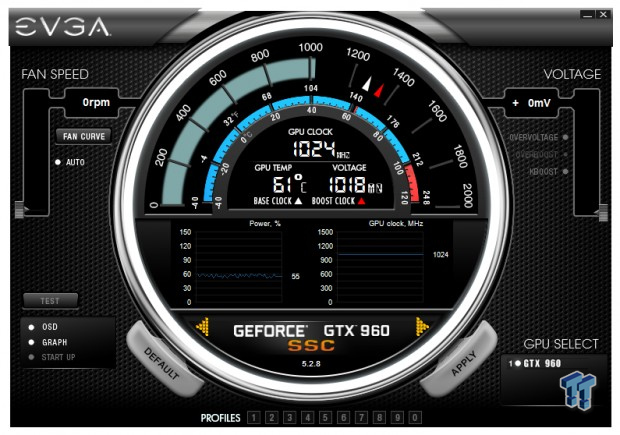
There are two yellow arrows to the left and right side of the GeForce GTX 960 SSD text at the bottom, which go between options. As you can see, the display is now different as you can see the power consumption and GPU clock compared to the first image where we could see the various power targets, etc.
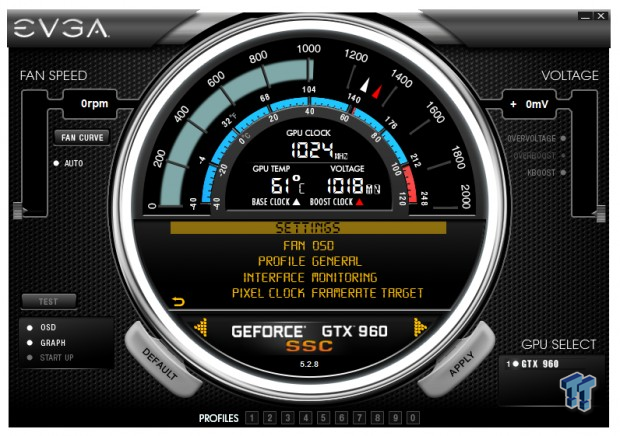
Next, you get a look at the Settings. Here, we have various settings for parts of the card like the OSD, fan, pixel clock, frame rate target and more.
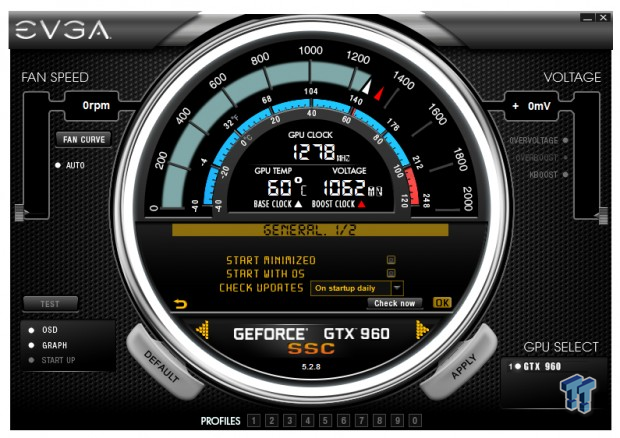
You can even get into the General part of the Settings menu and play with other parts of the PrecisionX software like having it start minimized, start with OS and check for updates at a scheduled time to your liking.
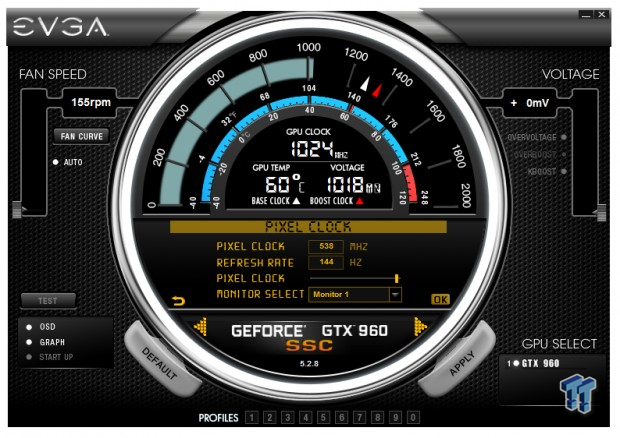
The pixel clock adjustment is a nice touch, as you can get down to the real nitty gritty of your monitors pixel clock, especially for overclocking your monitor (which you can do, by the way).
What's Hot, What's Not & Final Thoughts
This is where you can fast forward to the final section of the review, and get a quick recap and points on the EVGA GeForce GTX 960 SuperSC ACX 2.0+.
What's Hot
Silence: Something I'm beginning to love about these new GeForce GTX 960s is that they're all silent. The EVGA GeForce GTX 960 SuperSC ACX 2.0+ barely made a peep, and that's how I like it. Even sitting here in the darkness of night playing Battlefield 4, the fans might spin up every now and again, but there's next to no noise from the card 90% of the time.
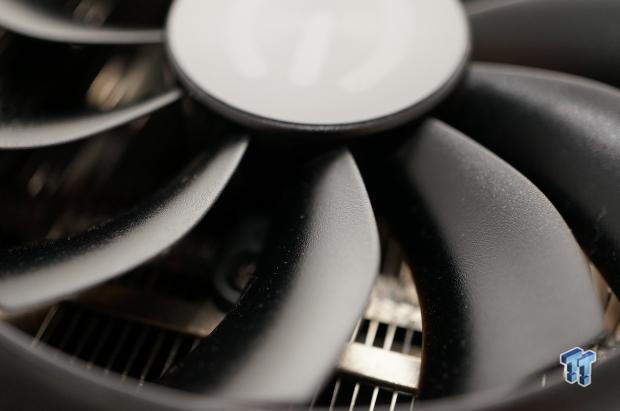
Impressive Cooling Technology: EVGA has quite an elaborate cooling setup on its GeForce GTX 960 SuperSC ACX 2.0+ video card, something that I really not only enjoyed the look of, but the performance. Even the back of the card, without a backplate, didn't get that hot during our extensive testing.
1080p 60FPS Gaming At Just Over $200: Nearly all of our games hit 60FPS at 1920x1080, with most of them easily performing higher than 60FPS. For $209, this is something that is worth calling home about.
Battlefield 4 + 1080p + 60FPS = YES!: For a $209 card, one wouldn't expect to crank Battlefield 4 up to its Ultra preset (minus AA) and exceed 60FPS, but the EVGA GeForce GTX 960 SuperSC ACX 2.0+ does that, and more.
Maxwell Architecture: As we detailed in our GeForce GTX 960 architecture overview article, NVIDIA has got some magic with its Maxwell architecture. EVGA takes this, and hits a home run with its GeForce GTX 960 SuperSC ACX 2.0+.
What's Not
Messy Overclocking Software: While EVGA's PrecisionX overclocking software looks great, it is a mess to work with. Most people are used to it because they have to be (testing GPUs all day long, or they've used PrecisionX from day one), but for someone who has never used it before, it can be incredibly confusing.
In saying that, this is a minor, minor touch. This has nothing to do with the overall feeling of the card, or how it performs for my judgment on the final thoughts below.
Final Thoughts
EVGA has impressed me throughout this entire review, from the initial packaging which is high quality, the actual box contents where you even get a sticker and poster, right down to the card. The card itself feels great to hold, and looks even better. But none of that matters, as we're all here for performance, right?
Well, gaming at over 1080p and 60FPS+ is something that the consoles can only dream of, but here we are with a $209 video card that does all of this without making noise, or at least not much at all. What magic does EVGA use? NVIDIA's Maxwell architecture, that's what. We have a slew of display outputs, a bloody impressive cooler in the ACX 2.0+ and so much more.
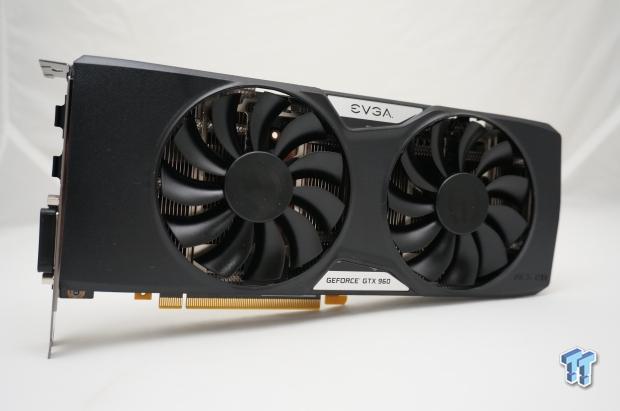
EVGA's overclocking software, PrecisionX, for me personally was a letdown. I didn't enjoy using it at all, and it is something that will be instantly uninstalled as soon as I'm finished with this review, which isn't long now.
Other than the software, everything else is near perfect for me. 1440p performance in Battlefield 4 was impressive, with Medium details netting us 105FPS average, while Ultra detail (minus AA) provided us with a more than playable 70FPS average. My nephew was standing behind me watching me play Battlefield 4 for our real-time multiplayer benchmarking, and he asked me which card I was testing.
I replied with "EVGA's GeForce GTX 960", but he thought I said GTX 980, so I continued playing. I was testing out the frame rate and alt-tabbing to put my FRAPS recordings into various folders, when he saw that GPU-Z was open and it said "GTX 960". He asked me if I meant GTX 980 or GTX 960 and when I replied with GTX 960, as an avid FPS gamer, his jaw dropped. He couldn't believe I was averaging 70FPS at 2560x1440 with Ultra (minus AA) details in BF4.
For $209, the EVGA GeForce GTX 960 SuperSC ACX 2.0+ is definitely a video card you will not regret purchasing. From the box to the card itself, you will not think EVGA has cut any corners. For gamers that are playing at 1440p or 1080p, this is a no-brainer. Even at 4K, you're still going to have a great time if you play around with the in-game detail settings in some of your games to tweak performance.
All-in-all, EVGA has a great GeForce GTX 960 here, something worthy of your $210 or thereabouts, that's for sure.
PRICING: You can find the EVGA GeForce GTX 960 SuperSC ACX 2.0+ 2GB GDDR5 for sale below. The prices listed are valid at the time of writing but can change at any time. Click the link to see the very latest pricing for the best deal.
United States: The EVGA GeForce GTX 960 SuperSC ACX 2.0+ 2GB GDDR5 retails for $209.99 at Amazon.

